40 Different Kalanchoe Varieties with Pictures
Are you intrigued by quirky plants? Dive into our guide on the captivating kalanchoe! Discover over 40 varieties, their unique traits, and enjoy stunning photos. Join us on this exciting plant adventure!
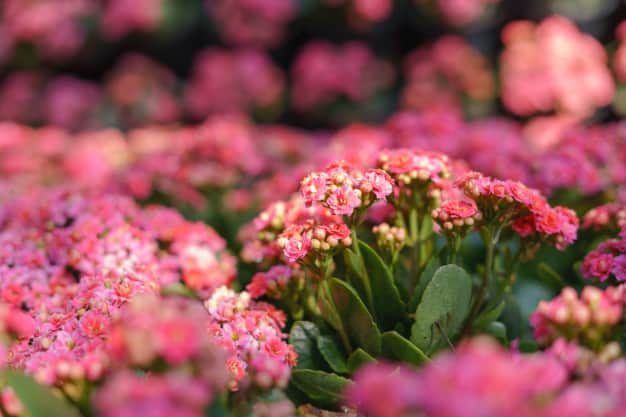
Contents
- 1 What exactly is a Kalanchoe plant?
- 2 List of Kalanchoe Lower Classifications
- 2.1 Kalanchoe arborescens
- 2.2 Kalanchoe beauverdii
- 2.3 Kalanchoe beharensis
- 2.4 Kalanchoe beharensis ‘Fang’
- 2.5 Kalanchoe beharensis ‘Oak Leaf’
- 2.6 Kalanchoe beharensis var subnuda
- 2.7 Kalanchoe blossfeldiana
- 2.8 Kalanchoe bracteata
- 2.9 Kalanchoe carnea
- 2.10 Kalanchoe citrina
- 2.11 Kalanchoe daigremontiana
- 2.12 Kalanchoe delagoensis
- 2.13 Kalanchoe eriophylla
- 2.14 Kalanchoe fedtschenkoi
- 2.15 Kalanchoe fedtschenkoi f. variegata
- 2.16 Kalanchoe fedtschenkoi f. variegata ‘Aurora Borealis’
- 2.17 Kalanchoe gastonis-bonnieri
- 2.18 Kalanchoe grandiflora
- 2.19 Kalanchoe humilis
- 2.20 Kalanchoe ‘Krinkle Red’
- 2.21 Kalanchoe laciniata
- 2.22 Kalanchoe laxiflora
- 2.23 Kalanchoe longiflora
- 2.24 Kalanchoe luciae
- 2.25 Kalanchoe luciae ‘Fantastic’
- 2.26 Kalanchoe marmorata
- 2.27 Kalanchoe marnieriana
- 2.28 Kalanchoe millotii
- 2.29 Kalanchoe miniata
- 2.30 Kalanchoe mortagei
- 2.31 Kalanchoe nyikae
- 2.32 Kalanchoe orgyalis
- 2.33 Kalanchoe paniculata
- 2.34 Kalanchoe ‘Pink Butterflies’
- 2.35 Kalanchoe pinnata
- 2.36 Kalanchoe prolifera
- 2.37 Kalanchoe pubescens
- 2.38 Kalanchoe pumila
- 2.39 Kalanchoe rhombopilosa
- 2.40 Kalanchoe rotundifolia
- 2.41 Kalanchoe scapigera
- 2.42 Kalanchoe sexangularis
- 2.43 Kalanchoe synsepala
- 2.44 Kalanchoe ‘Tessa’
- 2.45 Kalanchoe tetraphylla
- 2.46 Kalanchoe thyrsiflora
- 2.47 Kalanchoe tomentosa
- 2.48 Kalanchoe tomentosa ‘Chocolate Soldier’
- 2.49 Kalanchoe tomentosa f. variegata
- 2.50 Kalanchoe tubiflora
- 2.51 Kalanchoe uniflora
- 3 Kalanchoe Care Guide
- 4 Frequently Asked Questions (FAQs)
What exactly is a Kalanchoe plant?
Well, let’s start by saying that Kalanchoe is not just one plant, but a whole family of beautiful succulents. These plants are not only pretty to look at, but they also have a unique charm that sets them apart. In fact, they can be quite striking and peculiar in their appearance! And that’s not all – these plants are loved by both gardening enthusiasts and home decorators for a very special reason.
Most Kalanchoe plants are naturally resistant, which means they can thrive even in challenging conditions. So, whether you have a green thumb or simply love adding some natural beauty to your space, Kalanchoe plants are definitely worth considering!
List of Kalanchoe Lower Classifications
We’ve put together a list that includes both popular and lesser-known species. So, get ready to discover some familiar favorites and maybe even some surprises that are not commonly found in homes:
Kalanchoe arborescens
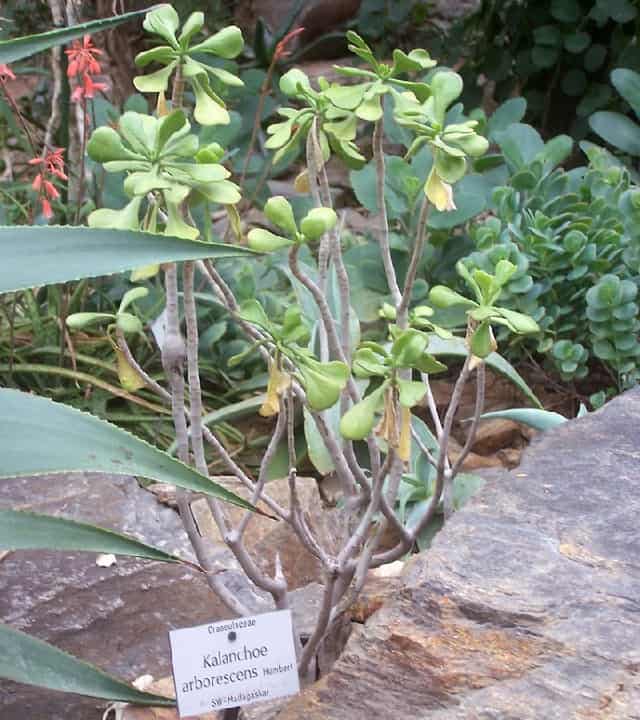
First, we have Kalanchoe arborescens, the largest type of kalanchoe that can grow up to eight meters in height. Also native to Madagascar, this plant forms small to medium-sized trees with a base stem diameter of up to 10 centimeters. Its inflorescences, showcasing vibrant pink and purple tones, are absolutely breathtaking.
Kalanchoe beauverdii
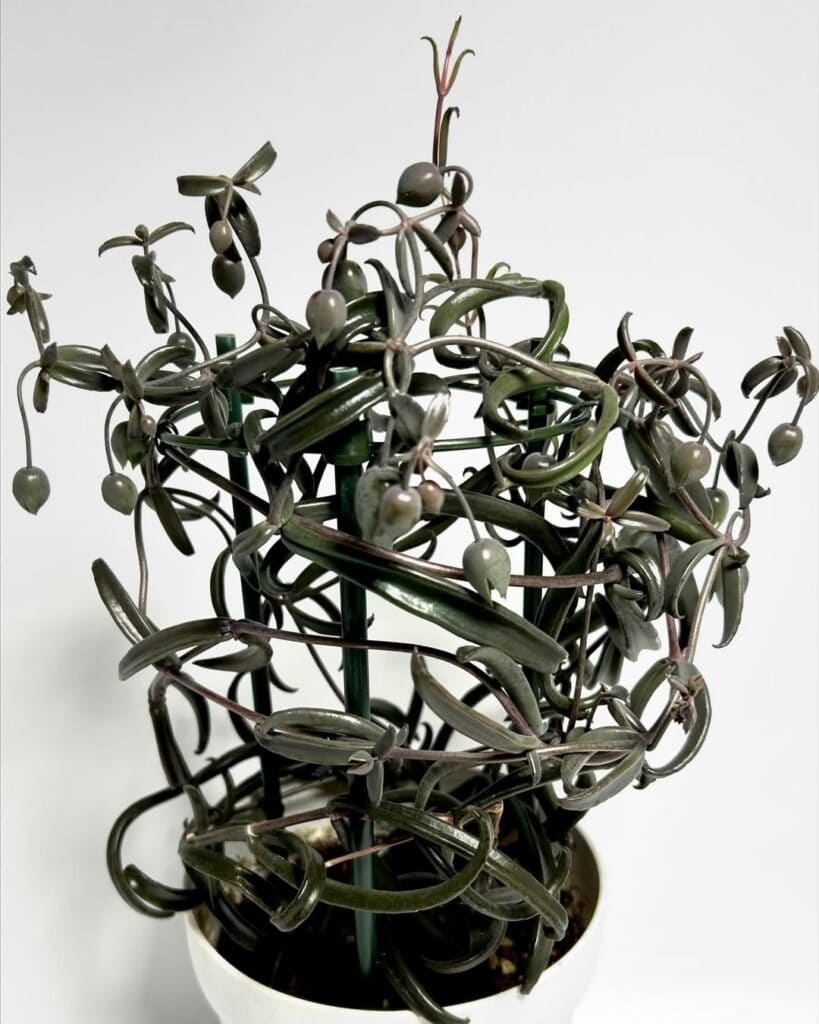
Kalanchoe beauverdii, commonly known as Beauverd’s widow’s-thrill, is a flowering plant from the Crassulaceae family. Named by Raymond Hamet in 1907, this perennial can reach heights of 3 to 5 meters. It’s native to Madagascar and the Comoros islands.
This plant is a succulent climber with slender stems streaked with purple and covered in a waxy coating. The stems can grow up to 5 meters long and tend to branch out, either trailing along the ground or climbing with support. The leaves come in various shapes and sizes, arranged in pairs that alternate direction, and can be up to 11 cm long and 4 cm wide, with many easily detachable bulbils on their edges.
Kalanchoe beauverdii thrives in the dry shrubland forests of southern and southwestern Madagascar, from sea level up to 850 meters in elevation. During the winter and spring seasons, it produces pale green to grey-green flowers with red-purple streaks, which hang in terminal clusters.
Kalanchoe beharensis
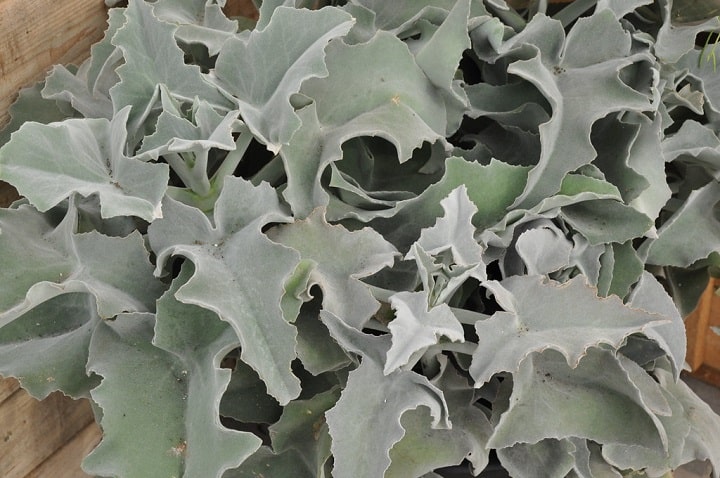
Native to Madagascar, Kalanchoe beharensis is known for its shrubby nature and impressive size, reaching heights of up to 10 feet. It resembles a small tree with its large fleshy leaves. Being an evergreen plant, it is commonly used to beautify gardens and outdoor spaces.
Kalanchoe beharensis ‘Fang’
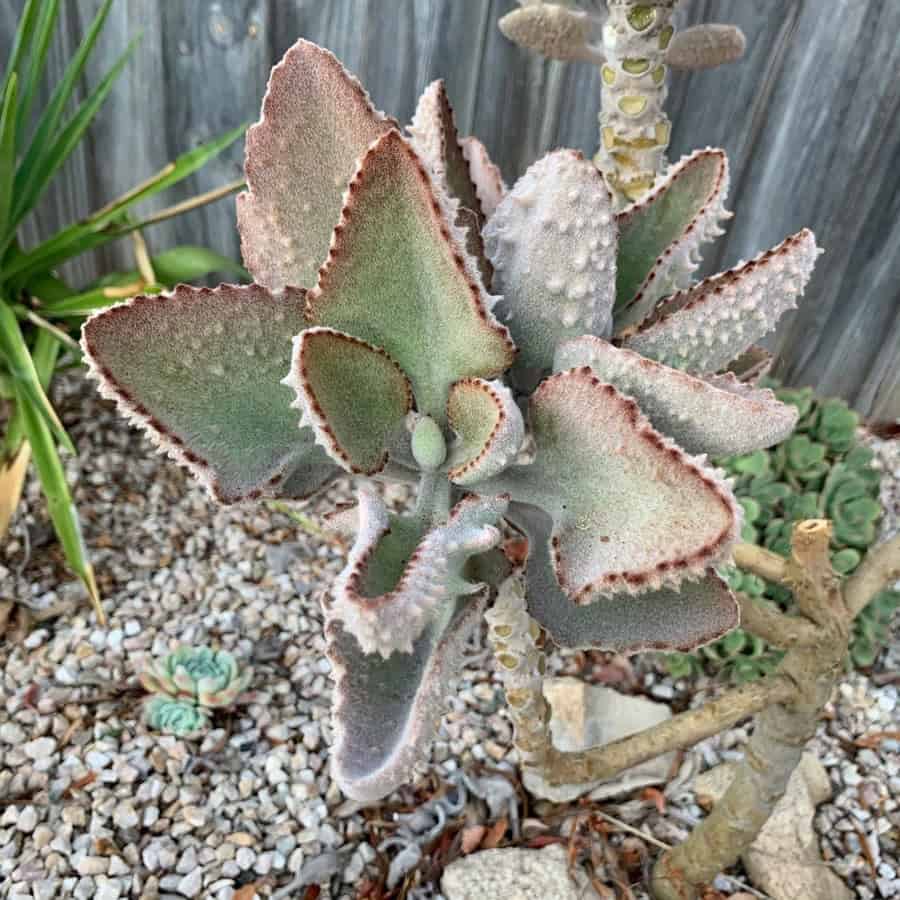
Kalanchoe beharensis ‘Fang’ is a bushy succulent that features upright, stocky stems and silvery green leaves. The leaves have a velvety texture and a lower surface covered in tubercles that look like sharp teeth. This plant can grow up to 3 feet tall. The leaves are fleshy, long-stalked, and deltoid with serrated edges, often appearing brownish on the upper surface with brown markings along the margins.
The flowers of Kalanchoe beharensis ‘Fang’ are urn-shaped, nearly white to pale yellow with pinkish-purple streaks, and bloom in many-flowered panicles on upright stalks during the summer.
This variety is quite similar to Kalanchoe ‘Roseleaf’, but ‘Fang’ has tubercles on the back of its leaves, which ‘Roseleaf’ lacks.
Kalanchoe beharensis ‘Oak Leaf’
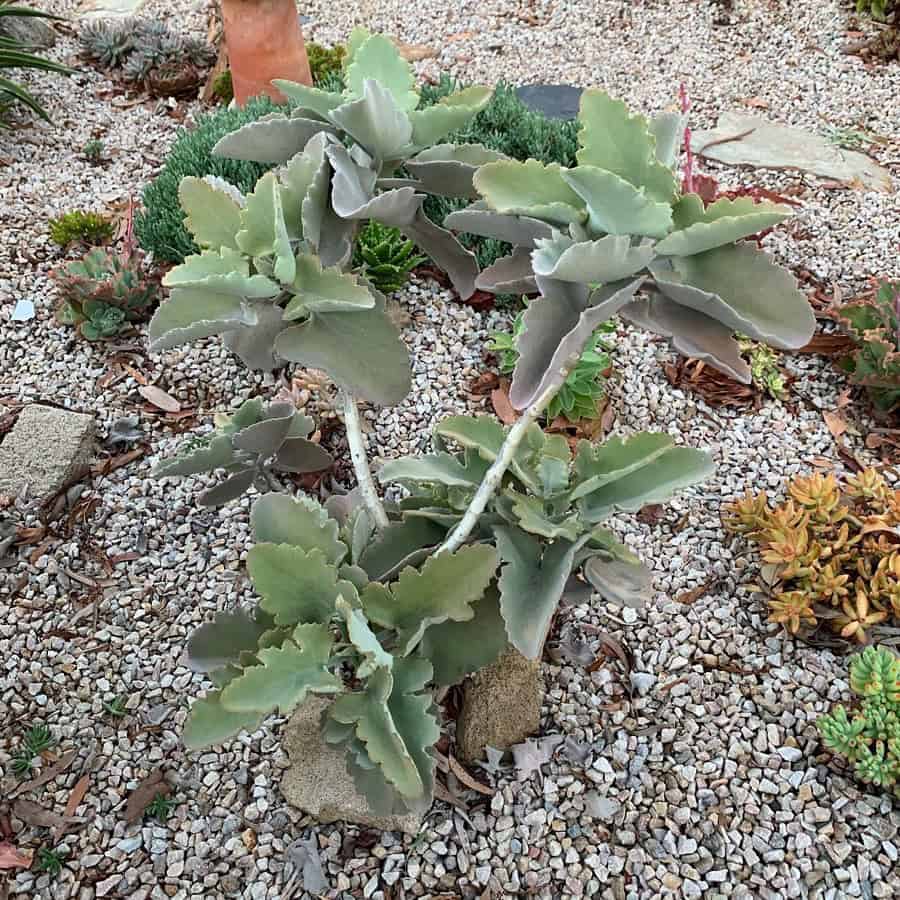
Kalanchoe ‘Oak Leaf’ (Dwarf Velvet Plant) is a densely-branched shrub that grows 2 to 3 feet tall. It has fuzzy, gray, lobed leaves with broadly dentate margins and produces small flesh-colored flowers in midsummer. The plant thrives in full sun to light shade and needs minimal irrigation. It’s an older hybrid attributed to Ed Hummel, likely a cross between Kalanchoe beharensis and Kalanchoe millotii.
Kalanchoe beharensis var subnuda
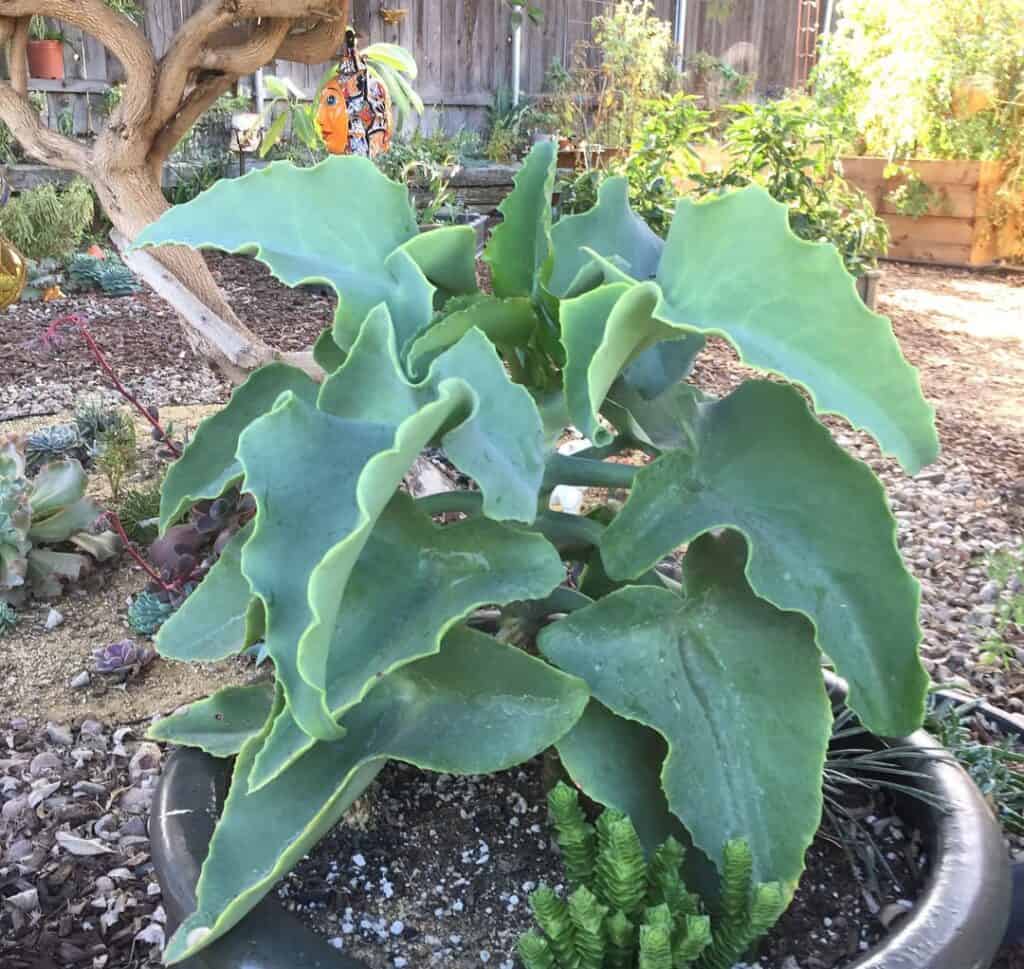
Kalanchoe beharensis var. subnuda, or Naked Feltleaf, is a hairless variety of the Kalanchoe beharensis, also called Velvet Elephant Ear.
Kalanchoe blossfeldiana
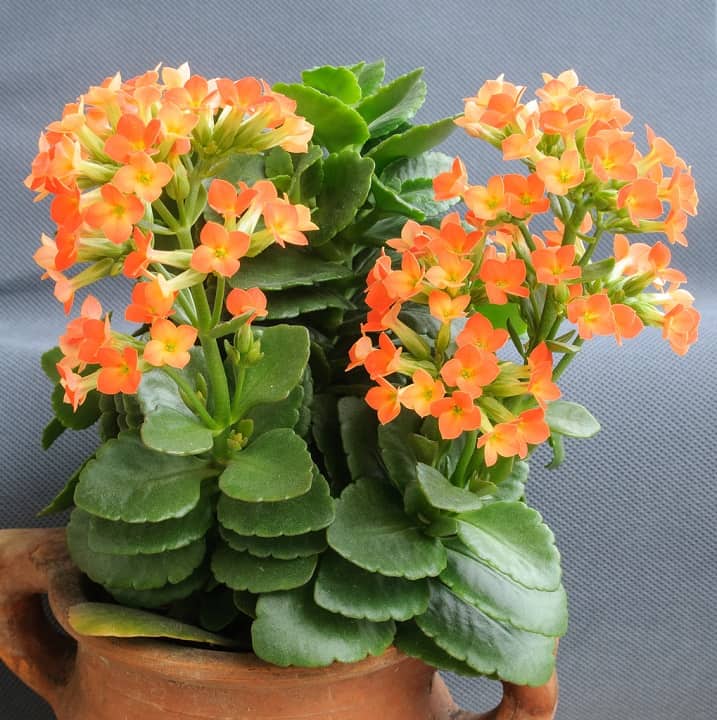
If you’re looking for a kalanchoe that’s a crowd favorite, then Kalanchoe blossfeldiana is the one for you! This plant is not only widely known but also commonly found in garden establishments. What makes it stand out are its vibrant and diverse-colored flowers, which are complemented by its large, intense green leaves. Just like any other plant, Kalanchoe blossfeldiana needs plenty of natural light to bloom. However, keep in mind that if the conditions are not ideal, it might not produce flowers every year.
Kalanchoe bracteata
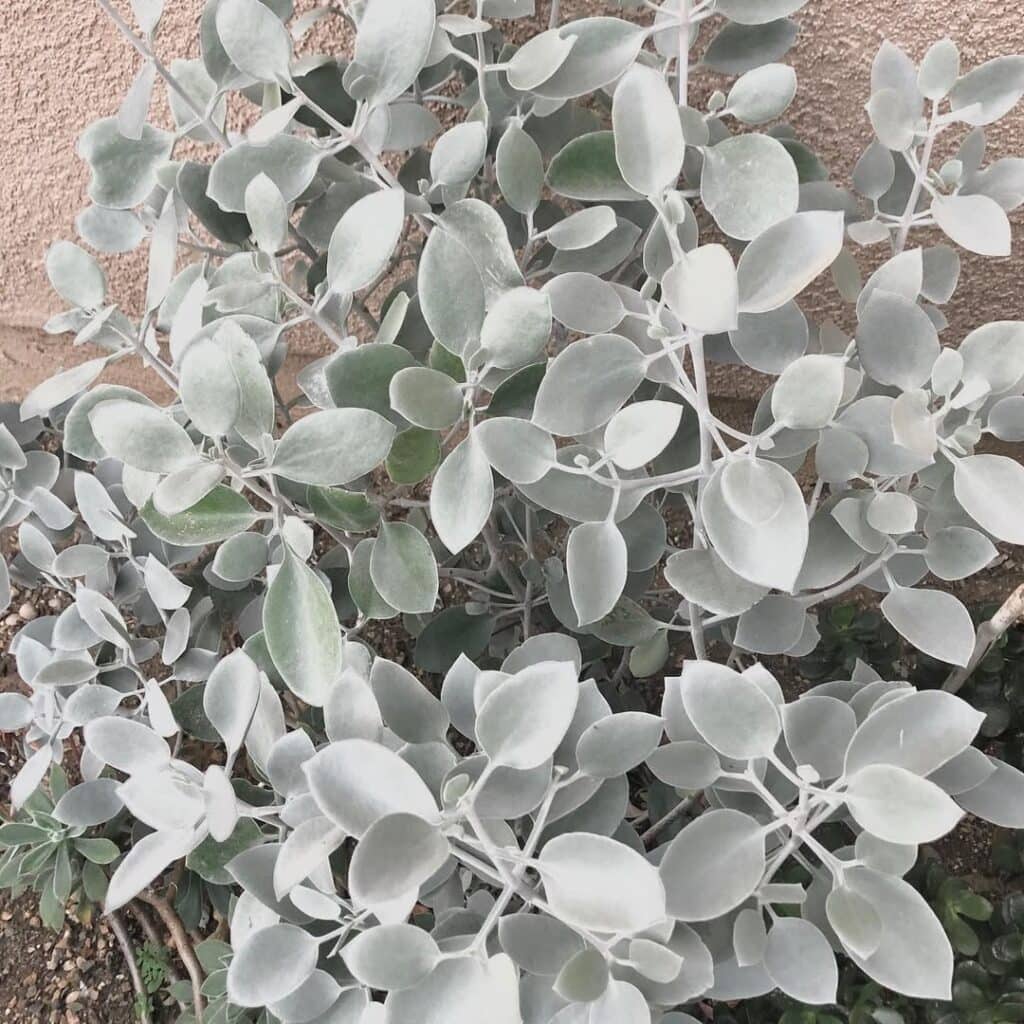
Kalanchoe bracteata is a succulent shrub that can grow up to 5 feet tall, with densely branched, woody stems. The leaves are fleshy and range from greyish-silvery-white to olive-green, covered in short hairs and a waxy secretion, giving them a smooth appearance. The young branches are subtly four-angled, and the leaves are elliptic to oblanceolate, with a short petiole and a slightly pointed tip, measuring up to 2.8 inches long and 1.6 inches wide.
In summer, the plant produces flowers arranged in cymes. Typical Kalanchoe bracteata has a silvery pubescence, but some varieties have smooth leaves. It is often confused with Kalanchoe orgyalis, which has yellow flowers with greenish lobes, while Kalanchoe bracteata’s flowers are red or orange-red. Additionally, Kalanchoe hildebrandtii, which has small white to yellow flowers and stalkless leaves, is a closely related species. Kalanchoe bracteata is unique for its plantlets that form on the flower stem and its 3-angled, two-lobed hairs.
Kalanchoe carnea
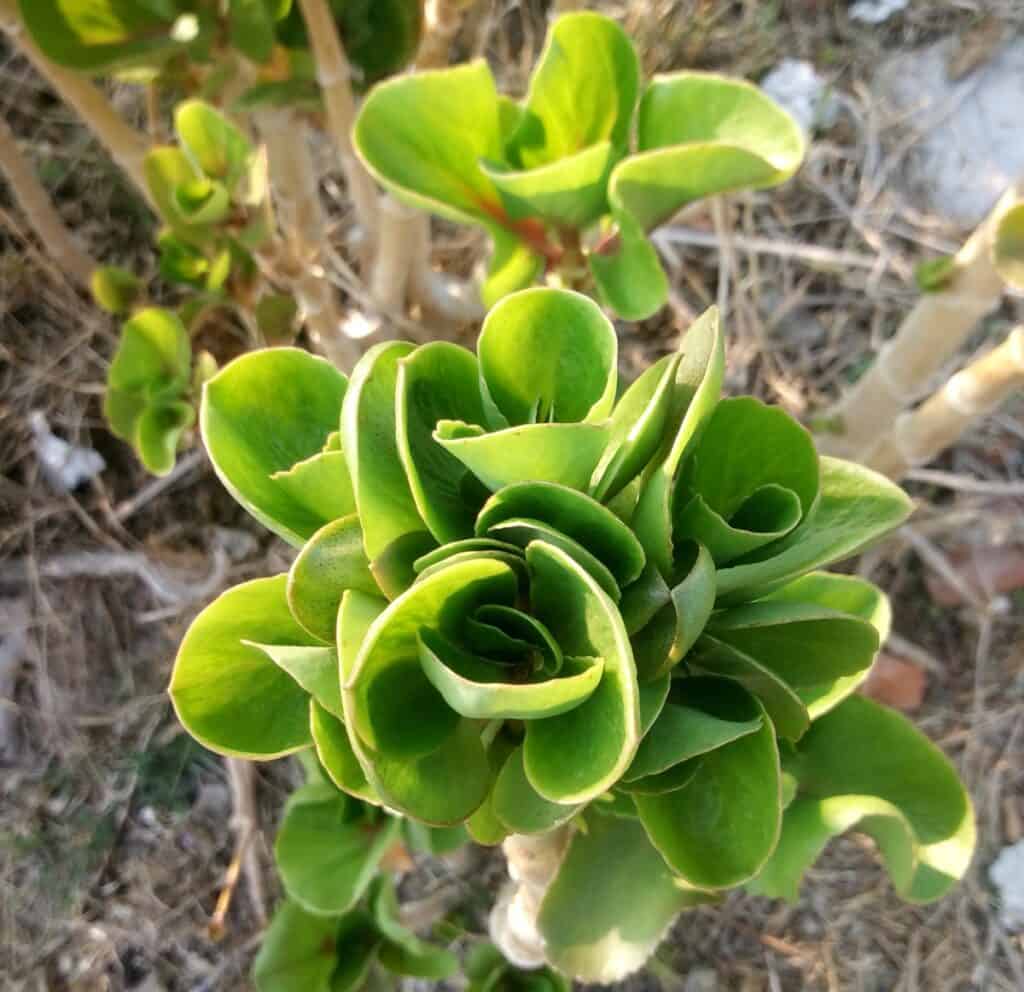
Kalanchoe carnea is an upright succulent that grows 3-4 feet tall. It has smooth green leaves with scalloped edges and produces showy pink flowers in summer. This plant thrives in both shade and full sun with minimal watering and can withstand temperatures down to the mid-20s Fahrenheit. Known for its resilience, it has been cultivated in Southern California for many years. Kalanchoe carnea is an Indian species first described in 1886, popular in Europe in the late 1800s and early 1900s.
Kalanchoe citrina
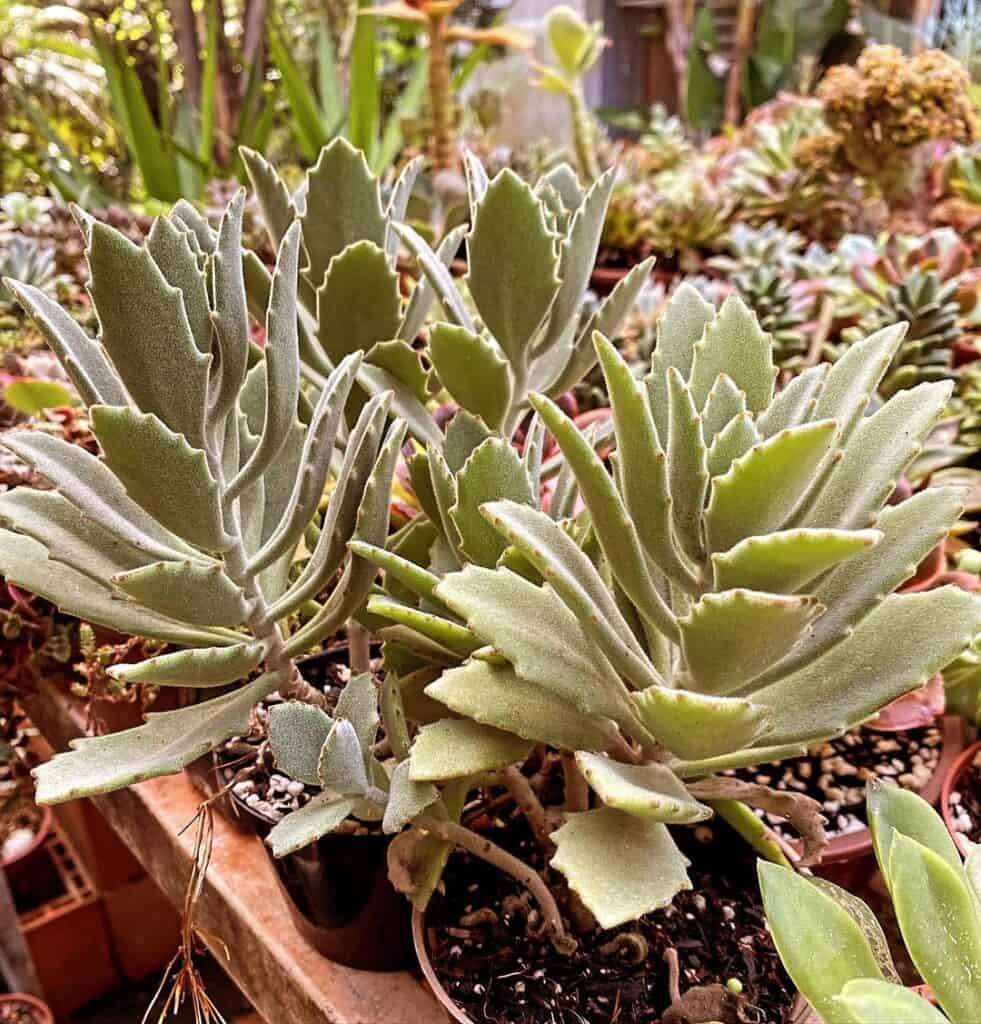
Kalanchoe citrina is a fuzzy-leaved succulent that blooms in mid-winter, producing yellow-gold flowers on long stalks.
Kalanchoe daigremontiana
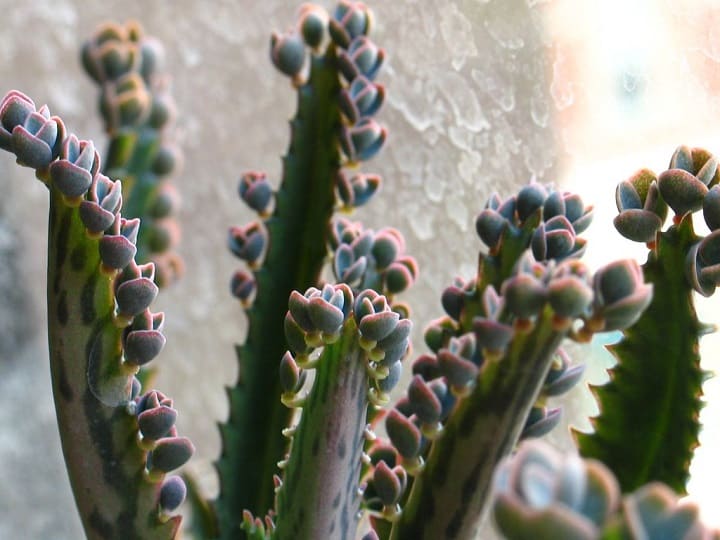
Kalanchoe daigremontiana is a top favorite among succulent aficionados. Its leaves, with serrated edges and dark spots on the underside, grow on sturdy erect stems. While it’s rare for this kalanchoe to bloom, you’ll notice many offspring sprouting from the jagged edges of its leaves, which is quite intriguing.
Kalanchoe delagoensis
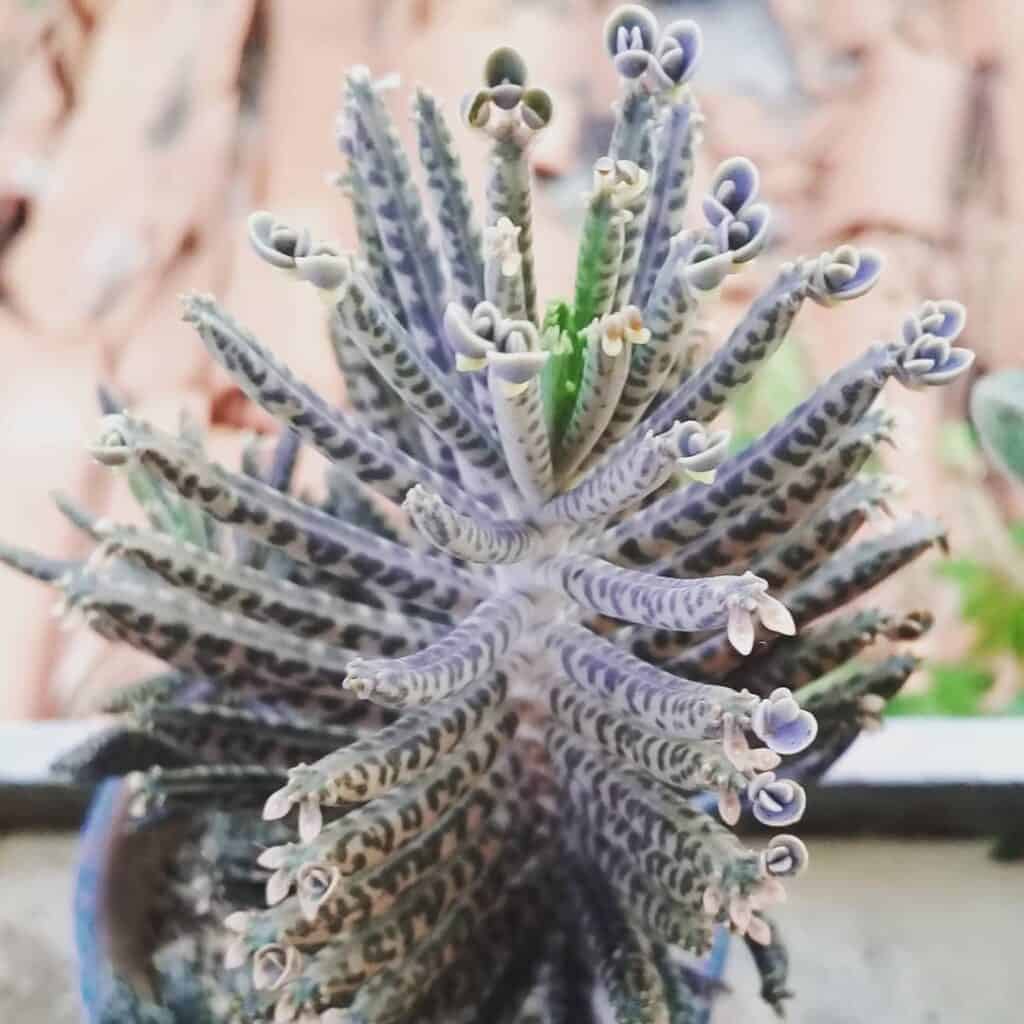
Kalanchoe delagoensis, known as “Mother of Thousands,” is a succulent that catches the eye with its unique appearance and ability to grow just about anywhere. It produces “plantlets” on the edges of its leaves that drop off and root wherever they land, including in unusual places like among cactus spines and on patios. This makes it easy to manage since the plantlets can be pulled out effortlessly.
This plant thrives in various conditions and is drought-resistant, which has helped it become invasive in regions like eastern Australia and several Pacific islands. It typically grows up to 1 meter tall and blooms in the winter. After blooming, the plant dies back, but new shoots can sprout from the roots.
Kalanchoe eriophylla
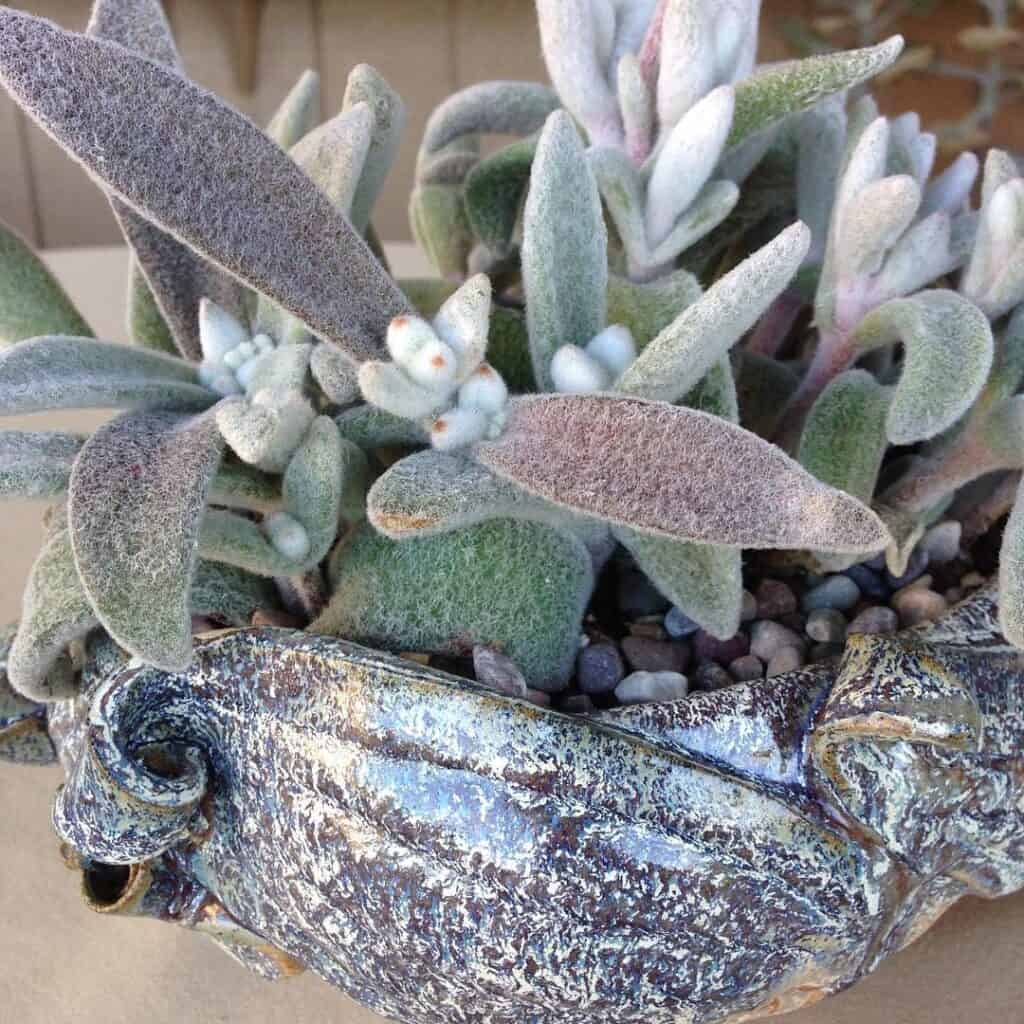
Kalanchoe eriophylla is a small, densely branched succulent that reaches up to 4 inches (10 cm) tall. Its green leaves are covered in a whitish or pinkish felt, giving them a silvery-white sheen. The main stem is slender, growing up to 12 inches (30 cm) long and rooting at the nodes. The branches can grow up to 2 inches (5 cm) long. When exposed to winter sun, the thick fleshy leaves turn deep crimson.
The plant produces bell-shaped flowers with four petals that vary in color from pink to violet or blue-violet. These flowers appear in clusters of 2 to 7 on stalks up to 8 inches (20 cm) tall in early spring.
Kalanchoe fedtschenkoi

Kalanchoe fedtschenkoi, also known as ‘South American Air Plant’ or ‘Lavender Scallops,’ is popular in tropical climates and as a houseplant in temperate areas. Its metallic green leaves can turn pink or red in strong sunlight or during drought. In winter, it produces purple or reddish-brown bell-shaped flowers that hang in loose clusters from upright stems.
Kalanchoe fedtschenkoi f. variegata
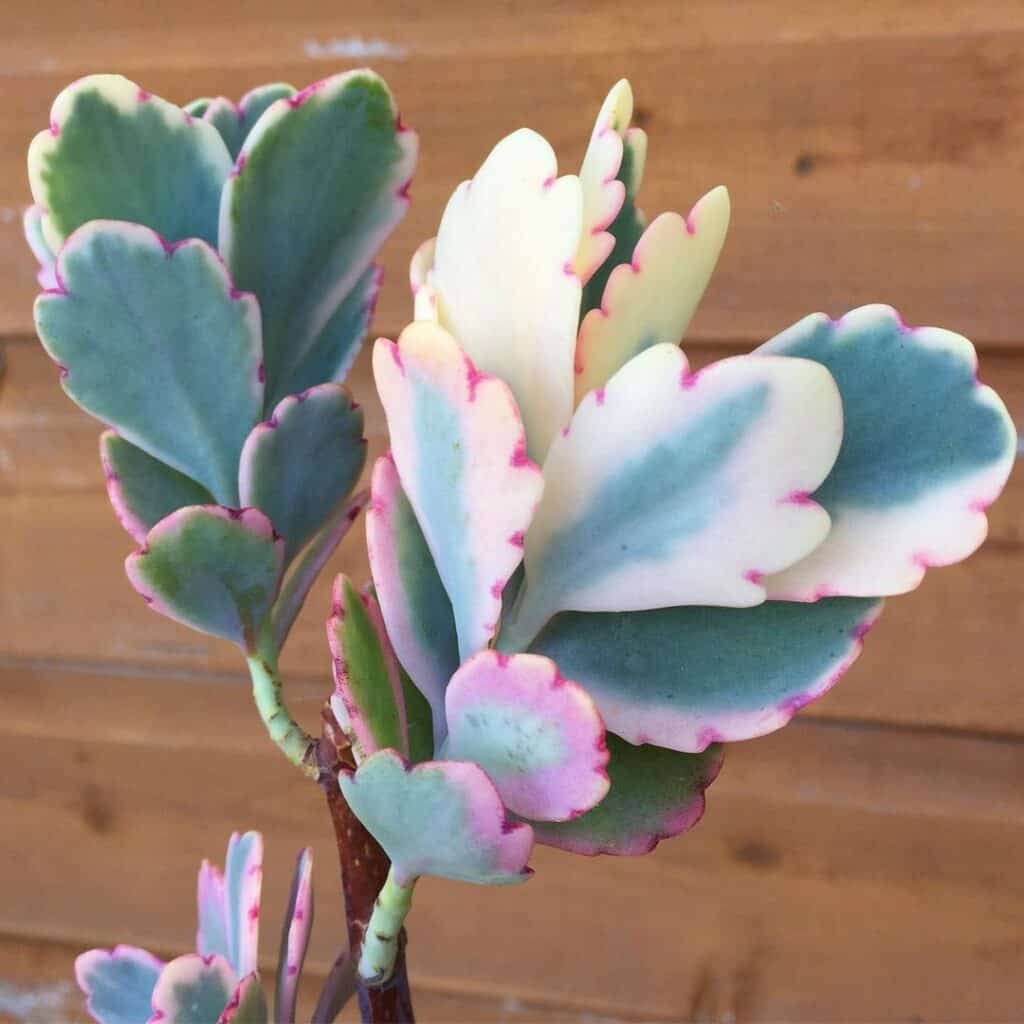
Kalanchoe fedtschenkoi f. variegata ‘Aurora Borealis’
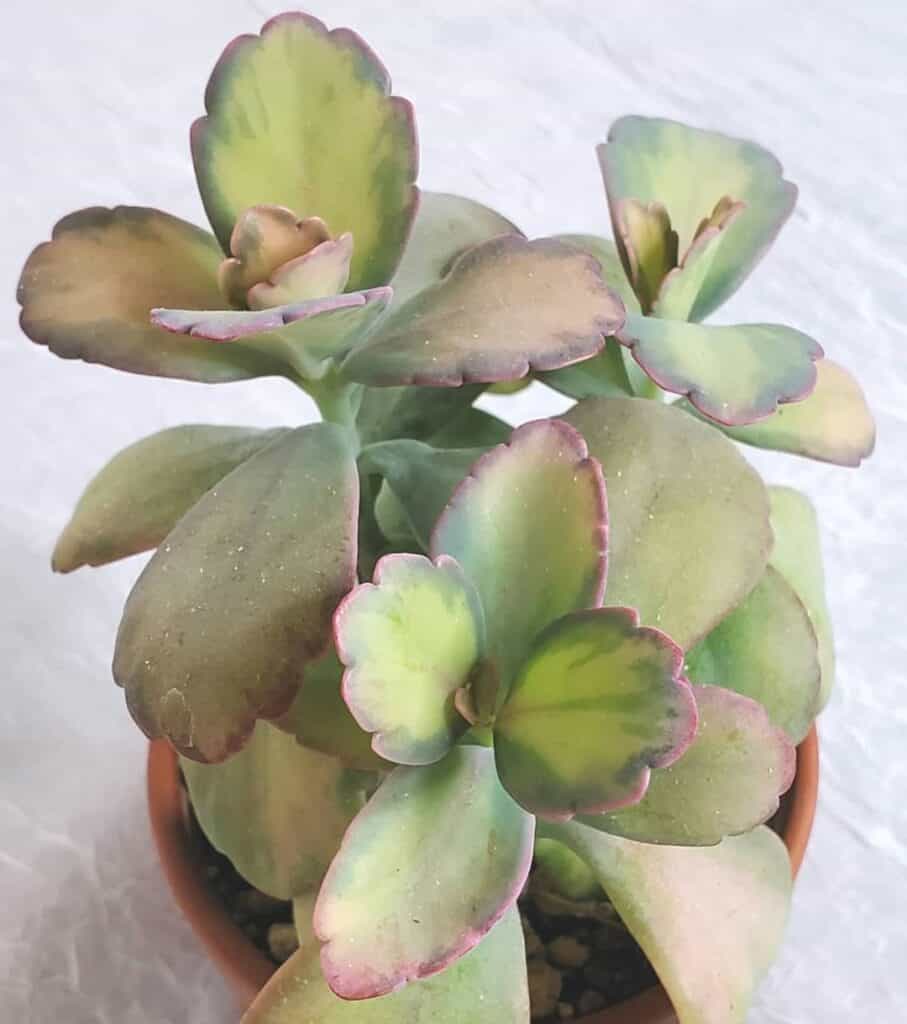
Kalanchoe fedtschenkoi f. variegata ‘Aurora Borealis’ is a stemmed succulent known for its striking foliage. The green leaves are edged with cream-colored variegation and have lightly scalloped edges that can turn bright pink in direct sunlight.
Kalanchoe gastonis-bonnieri
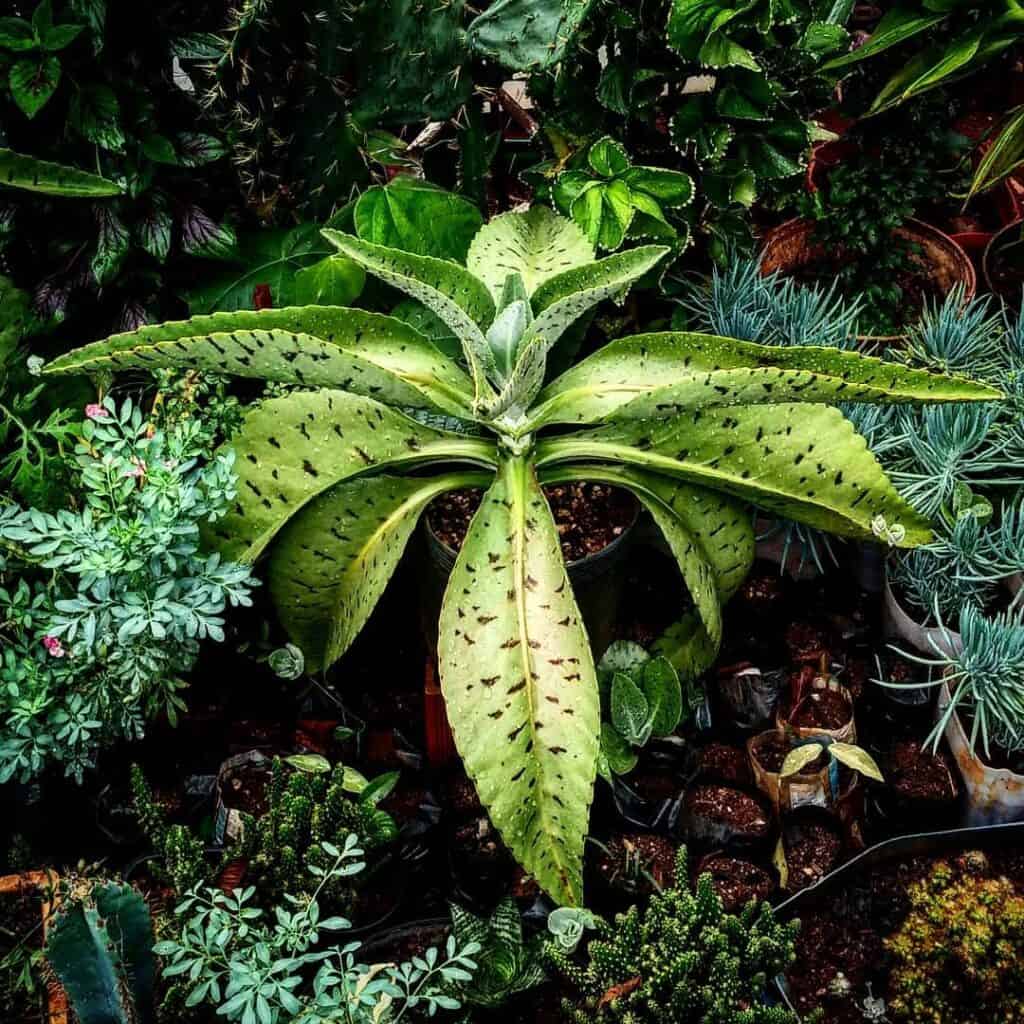
Kalanchoe gastonis-bonnieri is a fast-growing succulent that forms rosettes of green or gray-green leaves with maroon or dark green spots. The short, upright stems branch only at the base. Leaves can grow up to 20 inches long and 4 inches wide, with scalloped edges and small plantlets along the margins.
In fall, it produces yellow-green flowers with red or violet lines on tall stalks that can reach up to 3 feet high. The cylindrical flowers appear in clusters near the top of the stalk.
Kalanchoe grandiflora
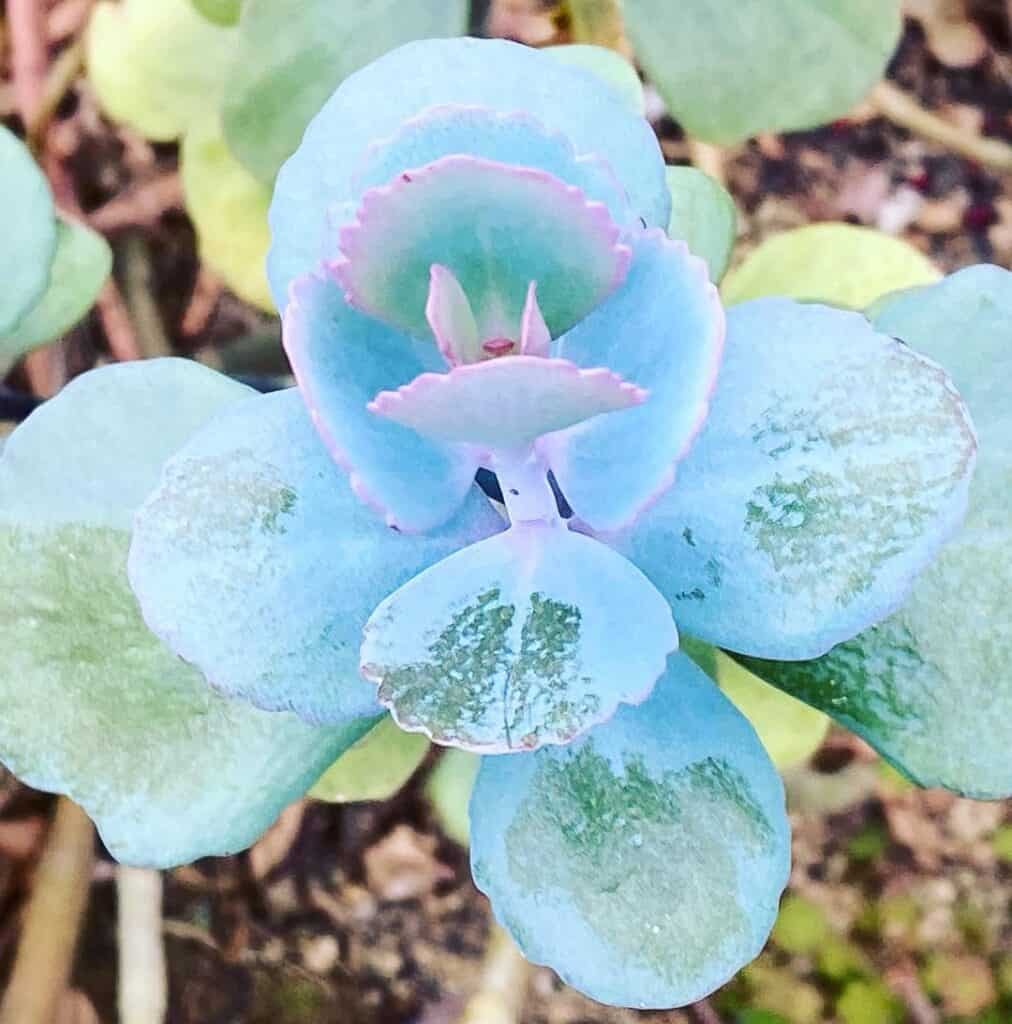
Kalanchoe grandiflora, also known as Yellow Kalanchoe, is a succulent from India. It grows up to 3 feet tall with thick, upright stems and blue-green, scalloped, oval leaves.
Kalanchoe humilis
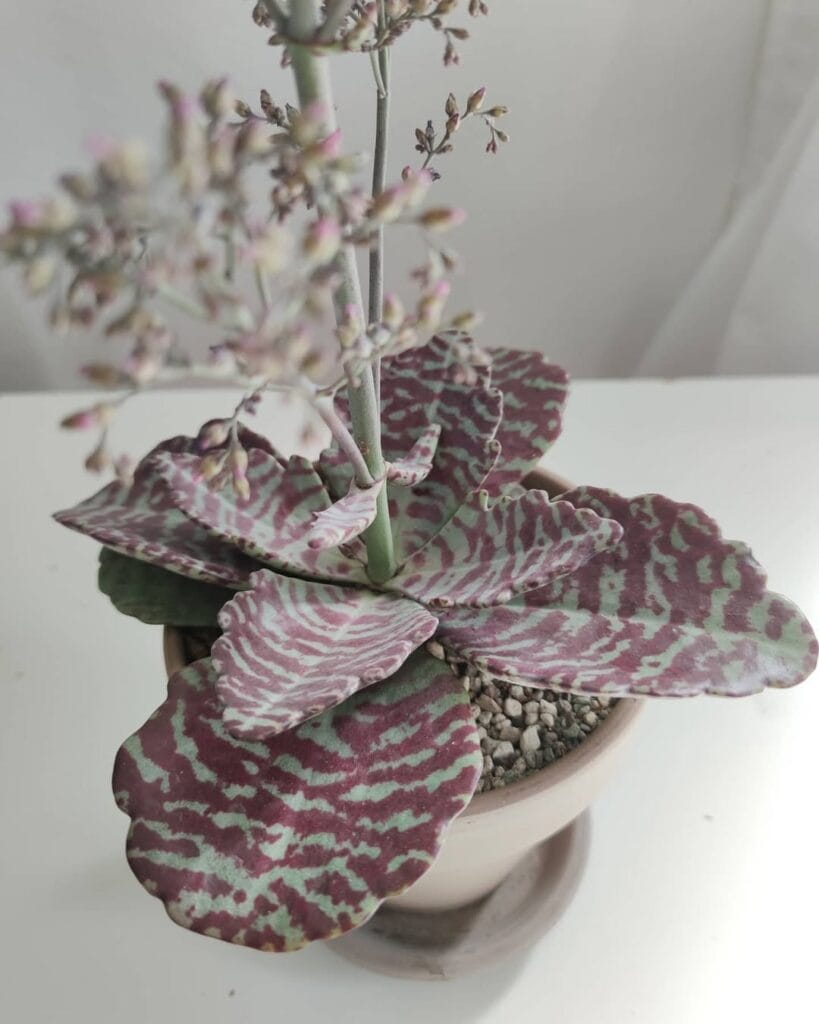
Kalanchoe humilis is a succulent shrub with pale green leaves that have purple or maroon spots. It can grow up to 3 feet tall with simple or few-branched stems that are woody at the base and purple or slightly glaucous. The egg-shaped leaves are up to 5.2 inches long and 2.4 inches wide, with a slight glaucous bloom and rounded teeth on the edges. In mid-summer, it produces small flowers that are purple to green, which appear in erect, branched clusters up to 12 inches tall.
Kalanchoe ‘Krinkle Red’

Kalanchoe laciniata
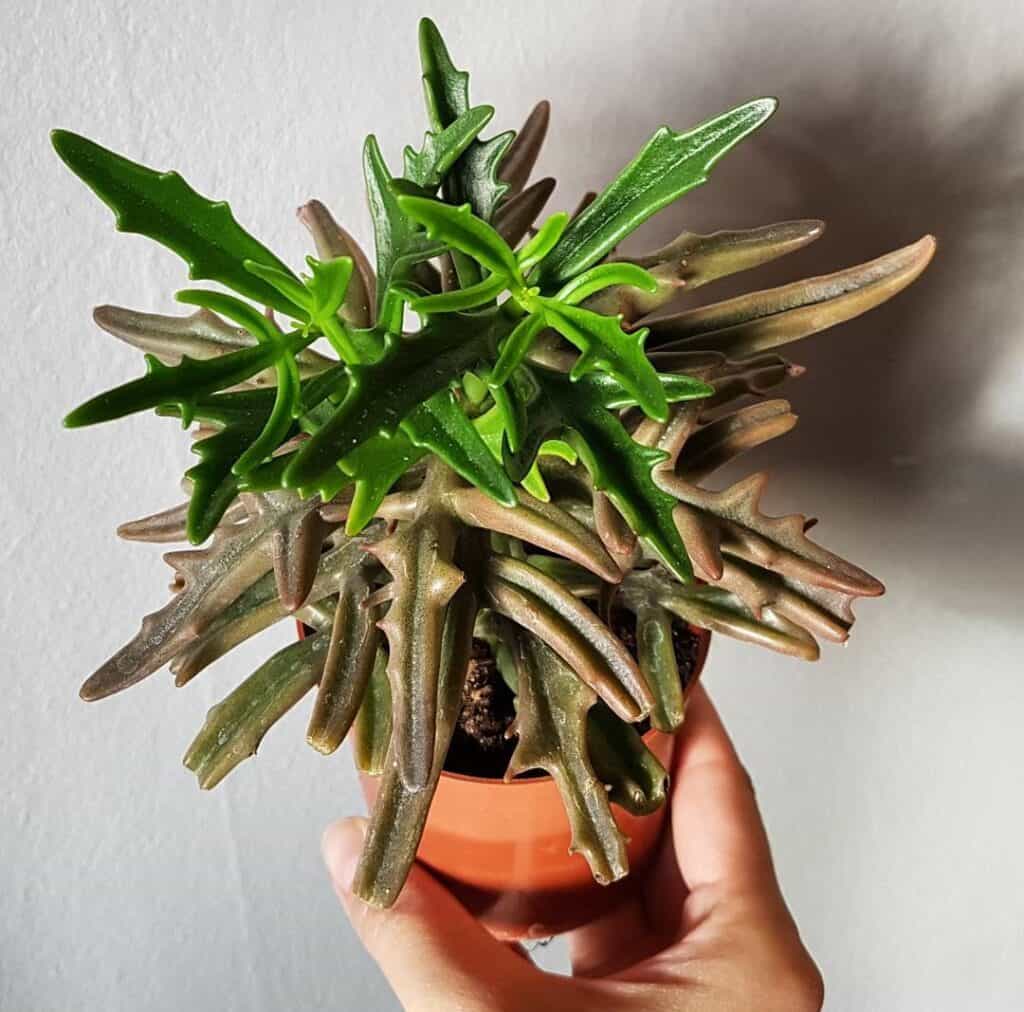
Kalanchoe laciniata, also known as the Christmas Tree Plant, is a succulent with a reddish stem and thick green leaves that can grow into various shapes. It can reach up to 5 feet tall. The leaves are often compound or dissected, with toothed or serrated edges, and can grow up to 5.6 inches long and 1.6 inches wide. In summer, it blooms with fragrant flowers that range from yellow to orange, forming dense clusters on stems that can be up to 2 feet tall.
Kalanchoe laxiflora

Kalanchoe laxiflora is a succulent shrub with upright woody stems and fleshy green to bluish-green leaves, often edged in red and sometimes with brown or red spots. It can reach up to 20 inches tall and branches from the base. The leaves are egg-shaped with toothed edges, attached to the stem by a petiole up to 2.4 inches long.
In spring, it produces tubular flowers with yellow-green to orange-red or violet calyxes and petals in various shades from reddish-purple to pale yellow. These flowers grow in dense clusters on stalks up to 20 inches tall.
Kalanchoe longiflora
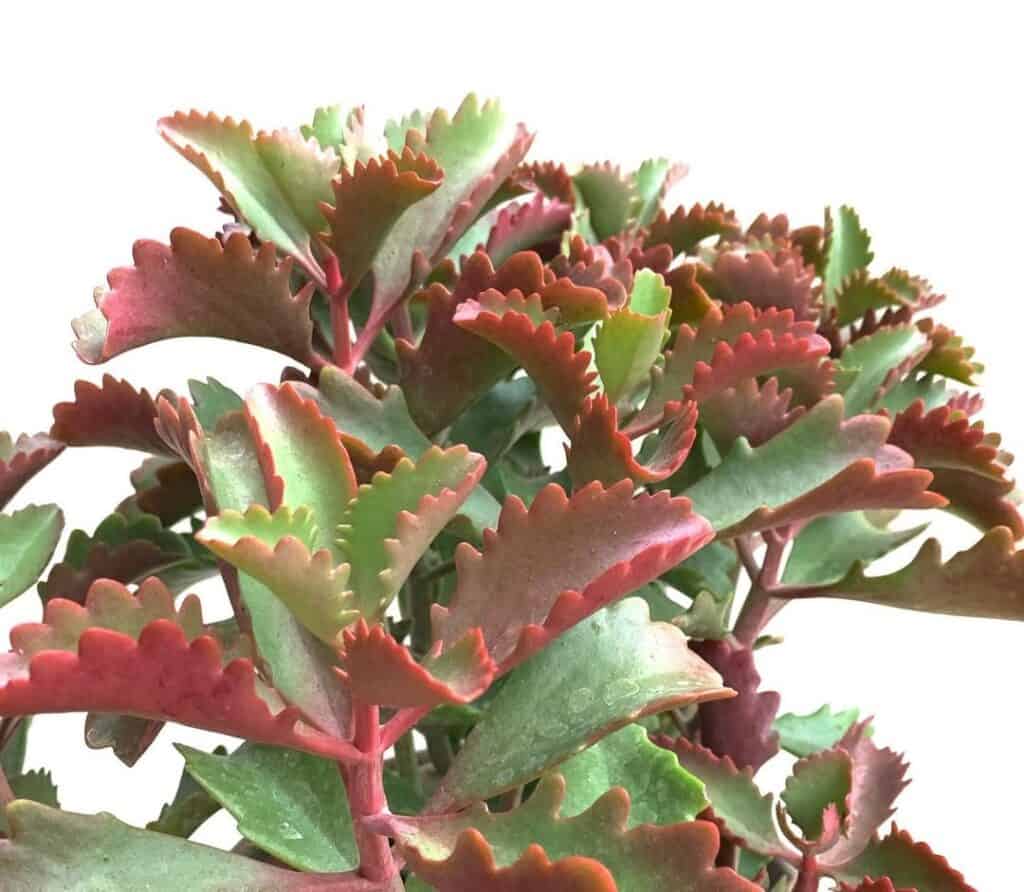
Kalanchoe longiflora is a succulent shrublet with four-angled branches and grey-green leaves that often have pinkish to reddish edges or are entirely reddish-brown. The fleshy branches, woody at the base, can grow up to 16 inches long, and the leaves, shaped like a limpet shell with toothed edges, can be up to 3.2 inches long and wide. This plant produces yellow to orange flowers in many-flowered clusters during fall and winter. It is often mistaken for Kalanchoe sexangularis but can be differentiated by its distinct quadrangular stems.
Kalanchoe luciae
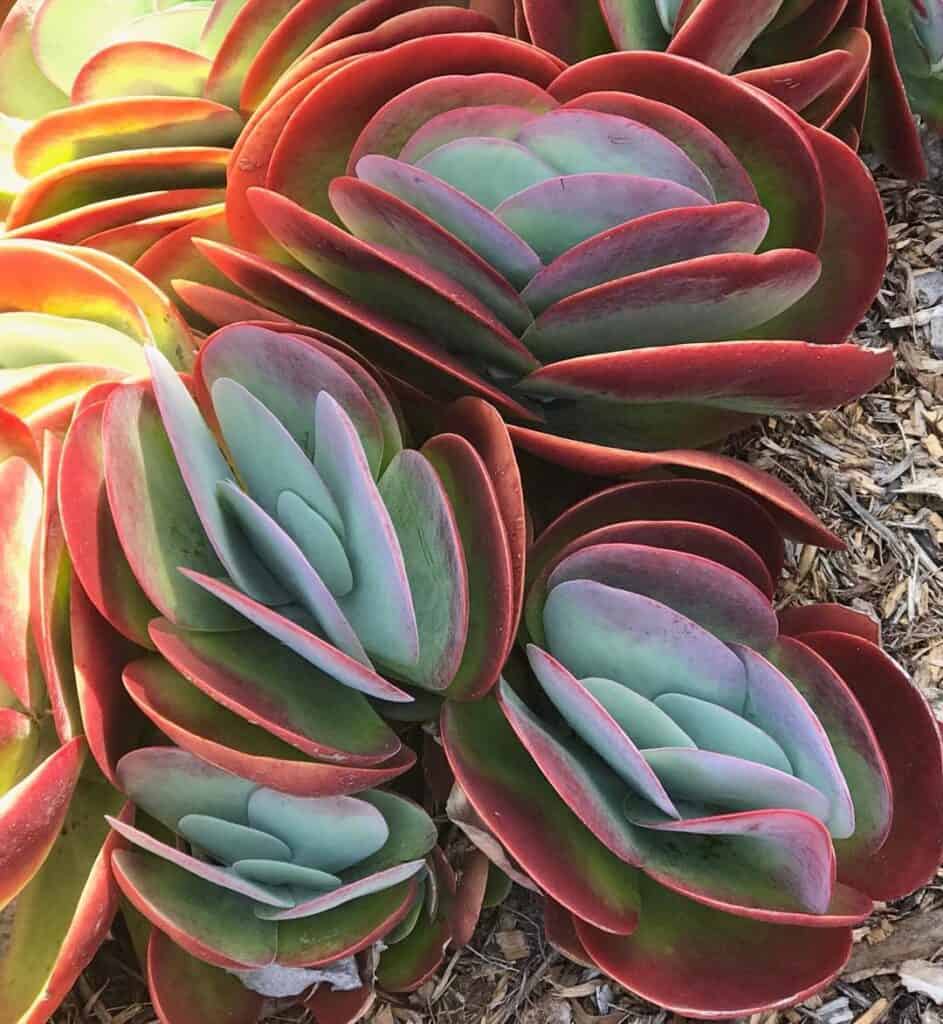
Kalanchoe luciae, also known as the flapjack succulent or paddle plant, is a striking plant with grey-green to yellowish-green leaves tinged with red at the edges. These leaves form rosettes that can be solitary or clustered, covered in a white, mealy layer that wears off with age. The leaves can grow up to 9.2 inches long and 6 inches wide. When exposed to direct sunlight and cooler temperatures, the leaf margins deepen in color.
This plant produces tall flowering stems up to 6.6 feet high with urn-shaped, pale yellowish-green flowers in late winter to early spring. Kalanchoe luciae is monocarpic, meaning the rosette dies after flowering but new offsets appear at its base. It is often mistaken for Kalanchoe thyrsiflora, which has smaller leaves that do not turn red and produces darker yellow, fragrant flowers.
Kalanchoe luciae ‘Fantastic’
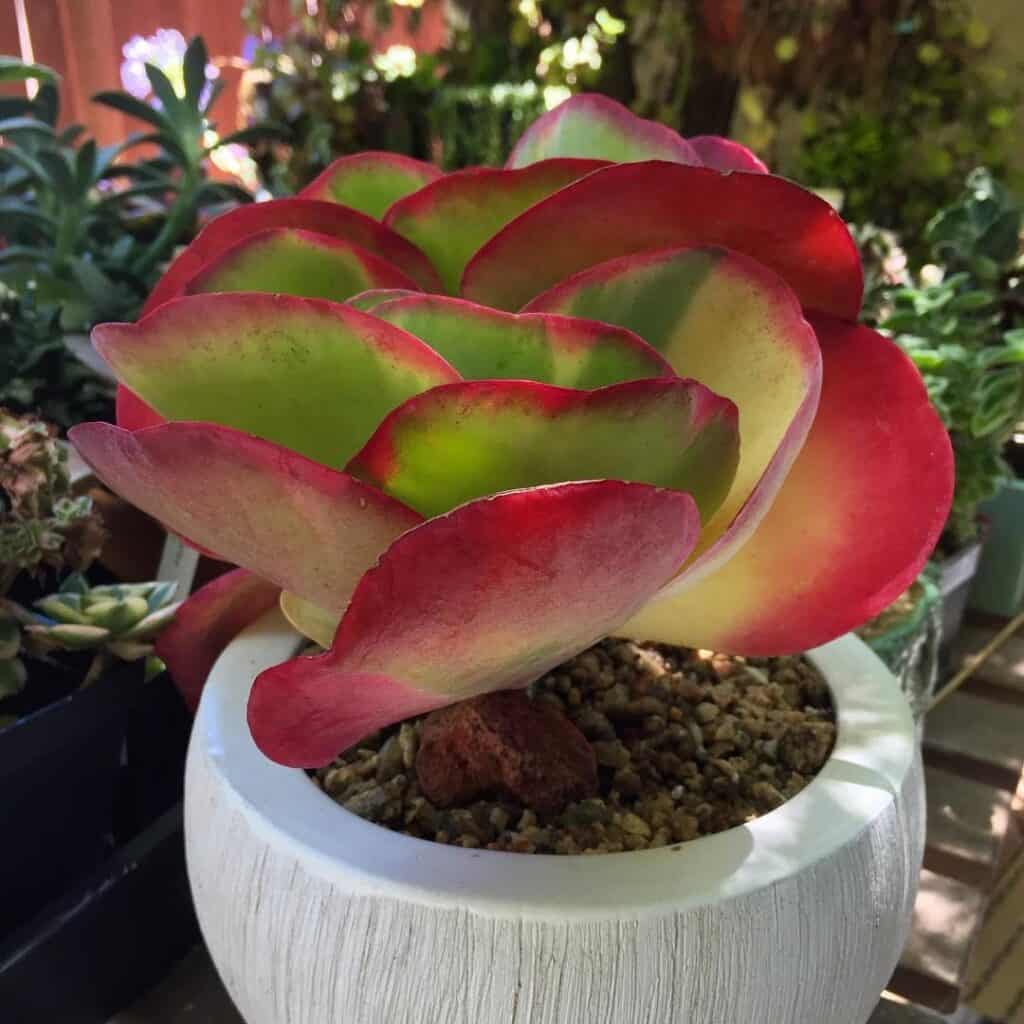
Kalanchoe luciae ‘Fantastic’ is a beautiful succulent with compact rosettes of broad, gray-green leaves featuring pale yellow stripes and reddish edges. The rosettes can grow up to 6 inches tall and 10 inches in diameter, with thick, clamshell-like leaves measuring up to 4.8 inches long and 4.4 inches wide. In late winter to early spring, it produces pale yellow, urn-shaped flowers that appear in clusters on a stalk up to 3 feet tall.
Kalanchoe marmorata
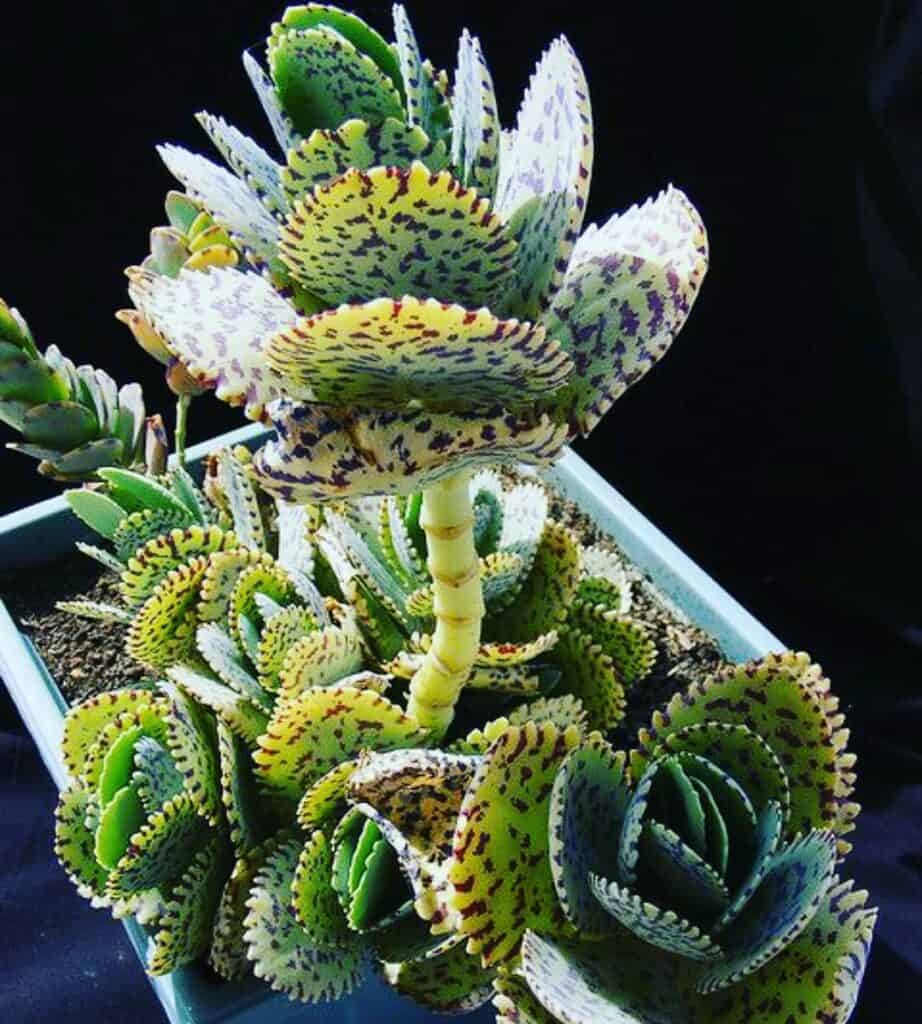
Kalanchoe marmorata, also known as the Penwiper Plant, is a succulent that grows up to 4.3 feet tall with erect or decumbent stems. Its glaucous grey-green leaves, often spotted with purple, are obovate or subcircular and can reach up to 8 inches long and 5 inches wide, with entire, undulate, crenate, or serrate margins. In winter to early spring, it produces slender, white flowers sometimes flushed with pale pink, arranged in paniculate cymes up to 1 foot long.
Kalanchoe marnieriana
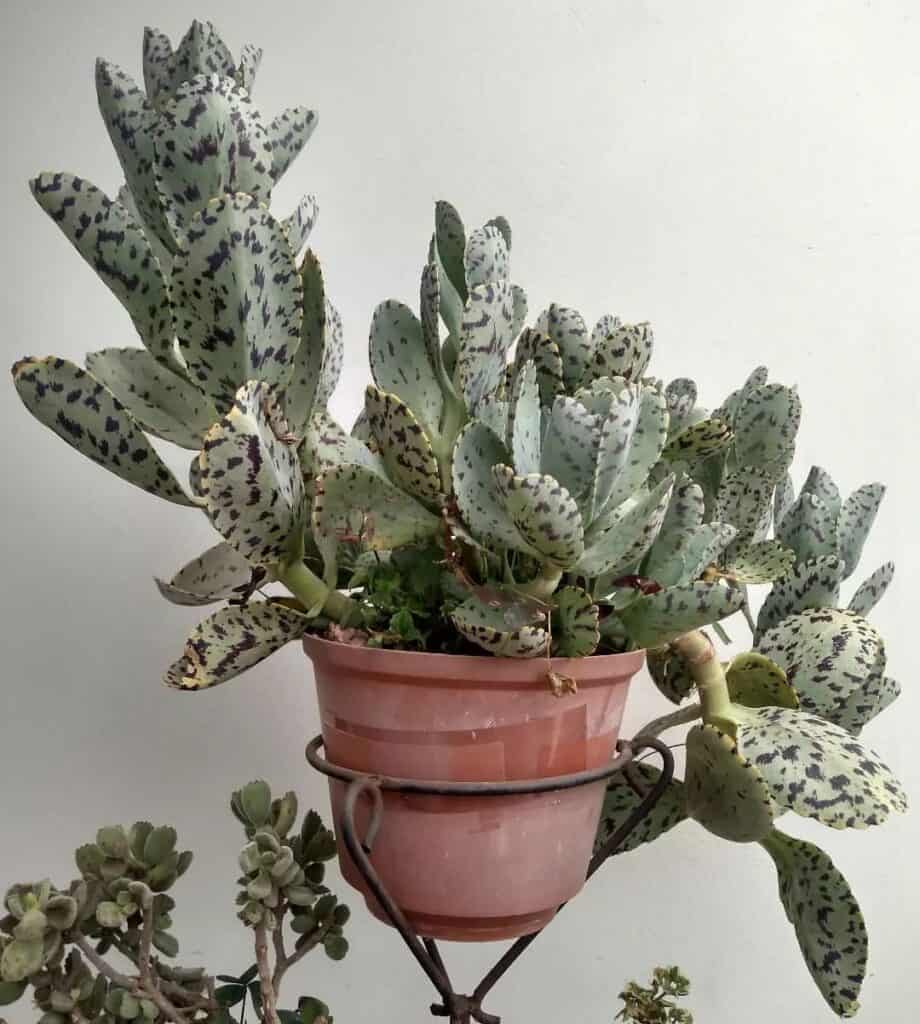
Kalanchoe marnieriana is a succulent with many branches and fleshy bluish-green leaves spotted with violet, often crowding near the tips of the slender branches. It grows up to 12 inches tall, with creeping branches that root at the base before ascending. The rounded leaves have a powdery bloom and can develop bulbils on the teeth. This plant produces orange to pink flowers up to 1.4 inches long, which hang from reddish stalks up to 4.8 inches long throughout the year.
Kalanchoe millotii
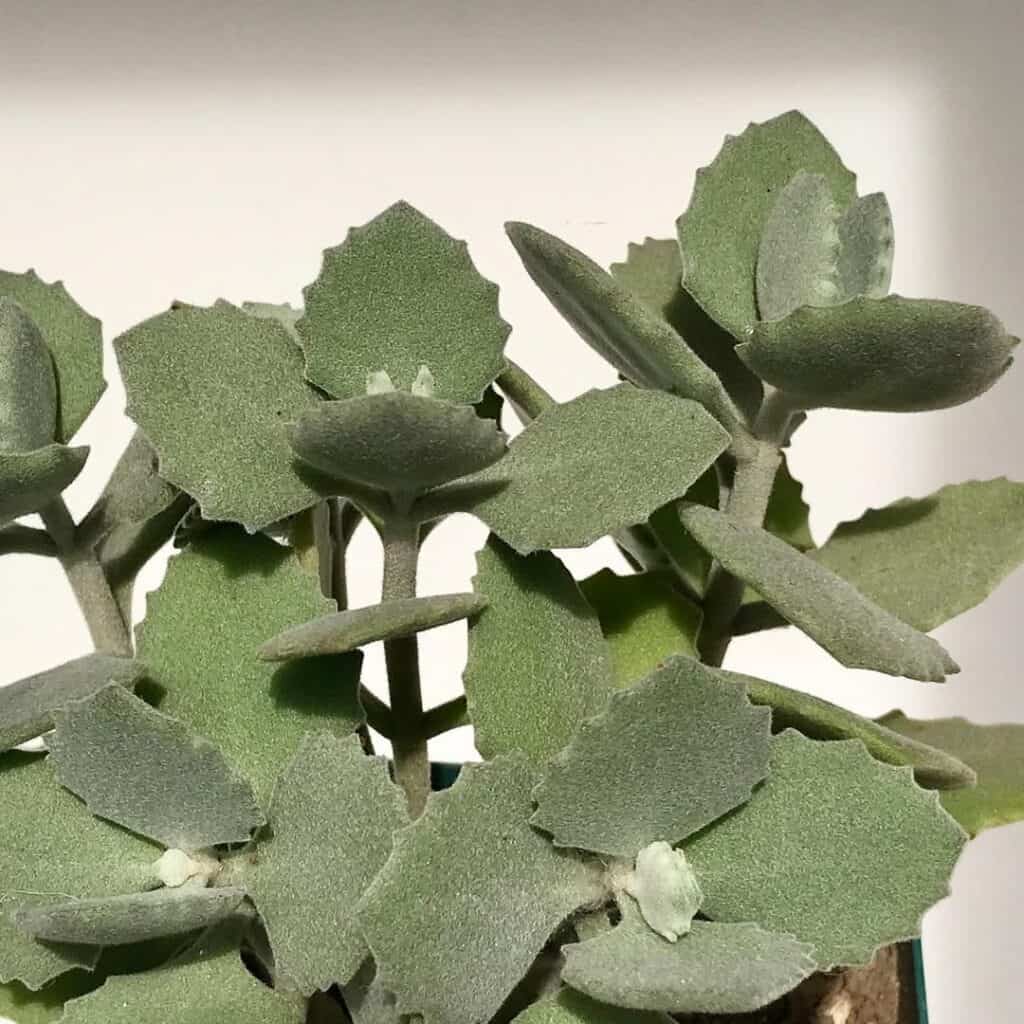
Kalanchoe millotii is a small succulent shrub with woody branches and green to greyish-green leaves, covered with tiny whitish hairs. It grows up to 3.3 feet tall. The leaves are round with scalloped edges, up to 6.5 cm long and nearly as wide. In summer, it produces small flowers with yellow-green to yellow-orange petals in dense clusters on 4-inch stalks.
Kalanchoe miniata
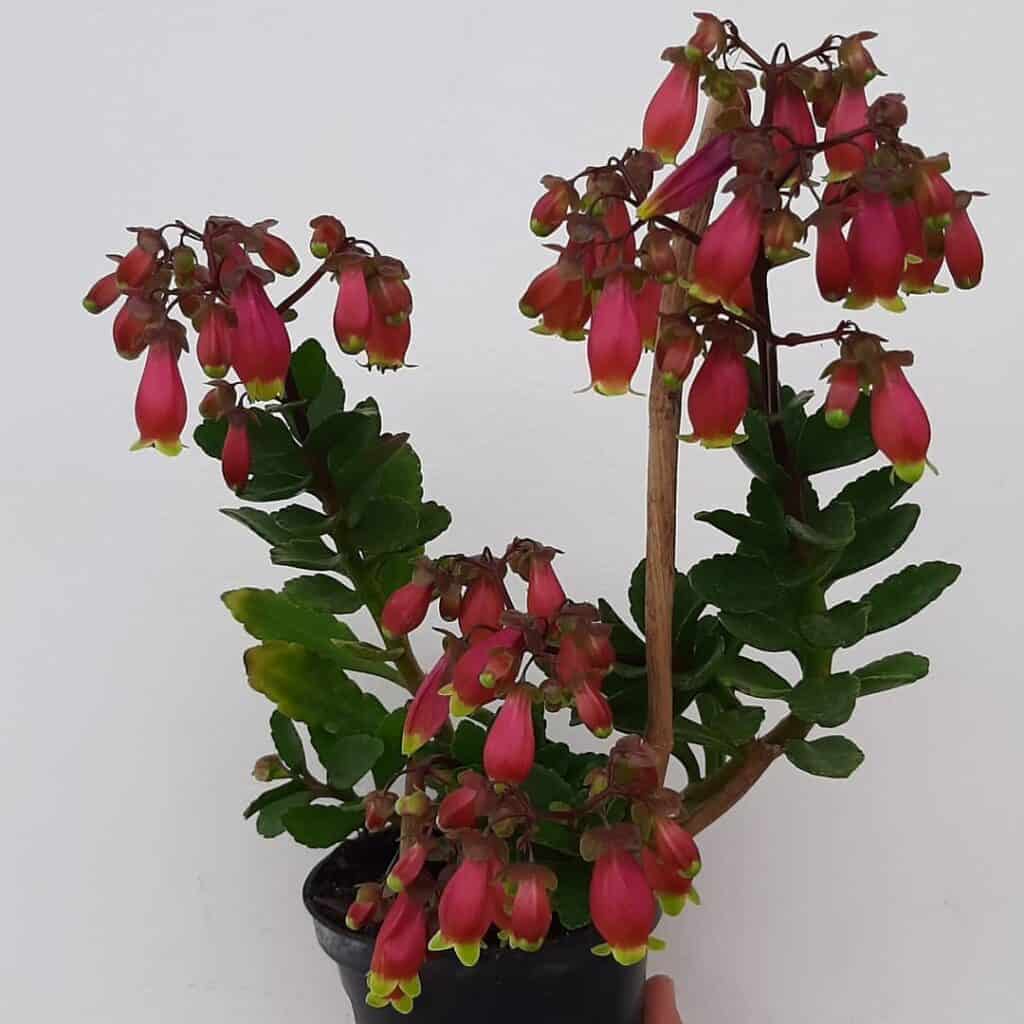
Kalanchoe mortagei
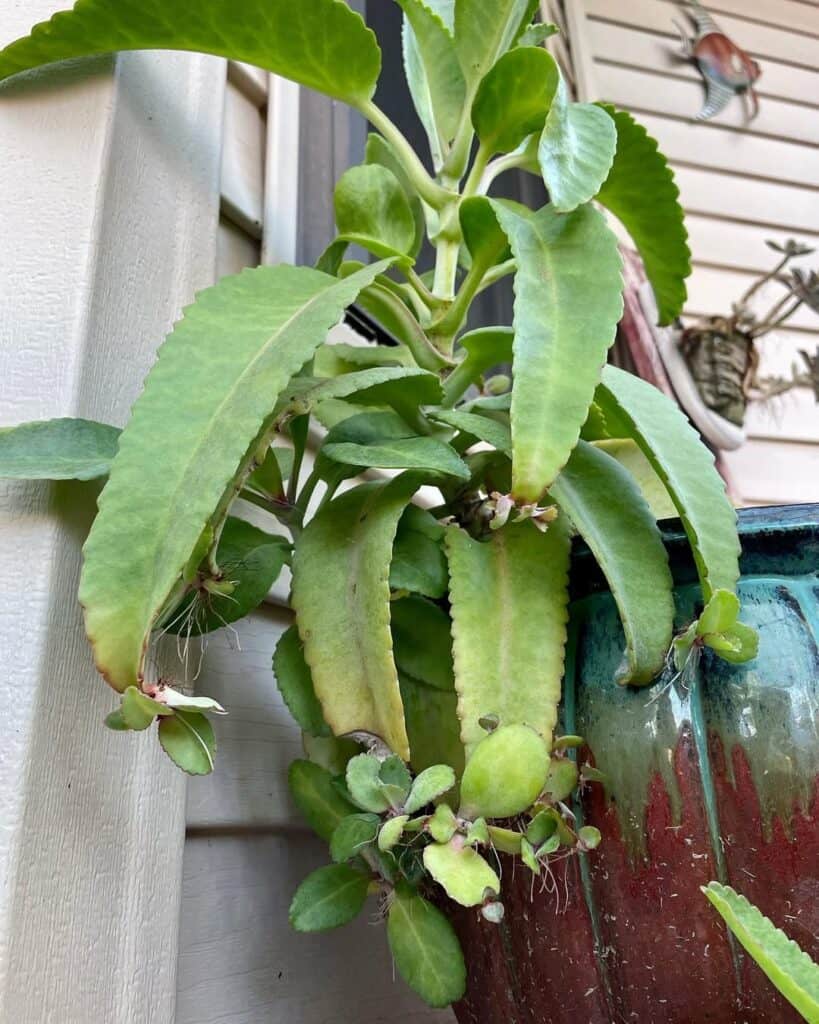
Kalanchoe nyikae
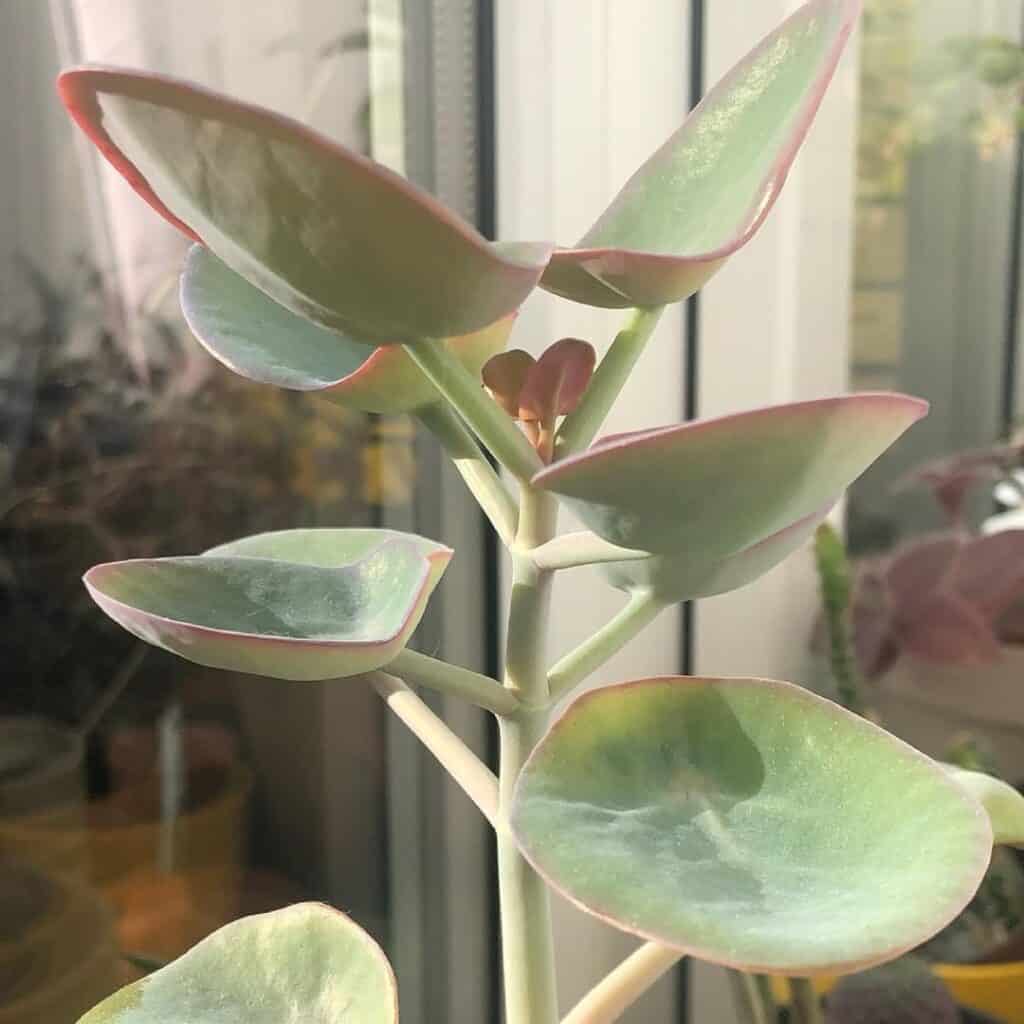
Kalanchoe nyikae is a succulent plant that grows up to 6.6 feet tall with stems that are sometimes erect and sometimes lie flat at the base. The brownish-green or glaucous leaves are covered with a frost-like bloom and are smooth with a paler underside. Leaves can reach up to 3.2 inches long and 2.8 inches wide, attached by petioles up to 4 inches long. The lower leaves are oval to round, while the upper ones are lance-shaped.
In spring, it produces many-flowered clusters with flowers that have a green calyx, a greenish corolla tube, and four petals that are cream on the outside and cream, yellow, pink, or salmon-pink on the inside. This plant is native to southeastern Kenya and northeastern Tanzania.
Kalanchoe orgyalis
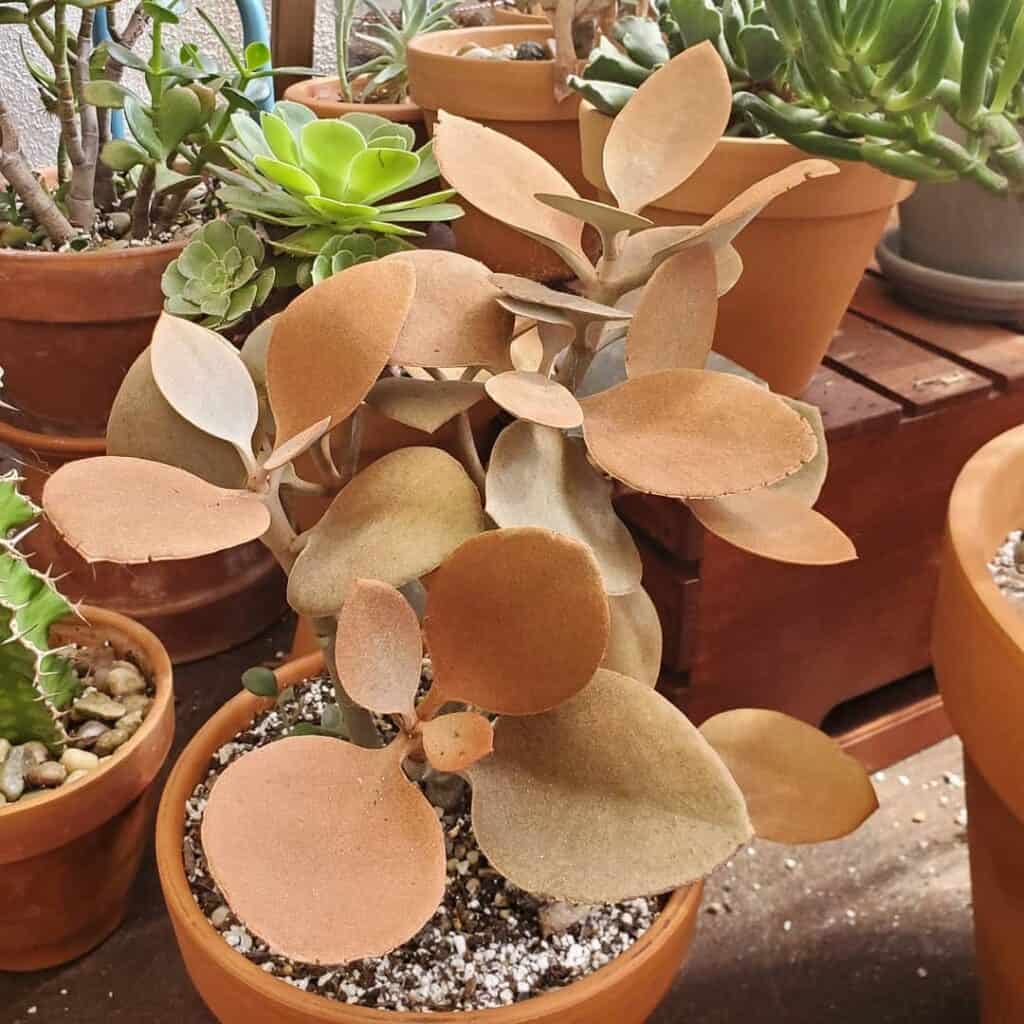
Kalanchoe orgyalis, also known as Copper Spoons, is a succulent shrub with erect, much-branched stems and fleshy, ovate leaves that fold upwards from the middle. It grows slowly and can reach up to 6.6 feet, though it is often smaller. The stems and leaves are covered with short hairs, giving them a glabrous appearance. The leaves are bronze to gray on the underside and have cinnamon-colored hairs on the top that fade to match the lower surface. Leaves are petiolate and can be up to 6 inches long and 4 inches wide. Bright yellow flowers appear in clusters at the tips of the branches from late winter to early spring.
Kalanchoe paniculata
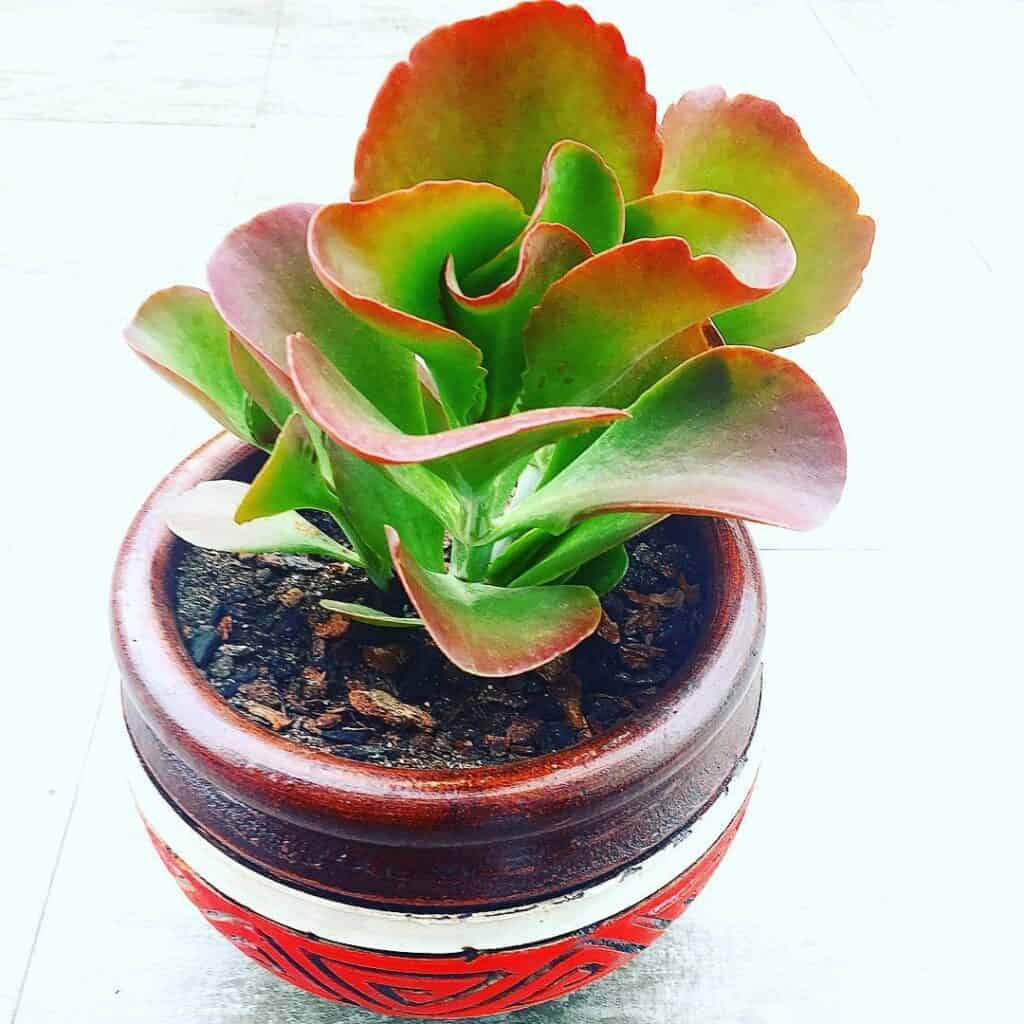
Kalanchoe paniculata is a strong succulent that grows tall and features a striking display of yellow to red flowers on a high inflorescence.
Kalanchoe ‘Pink Butterflies’
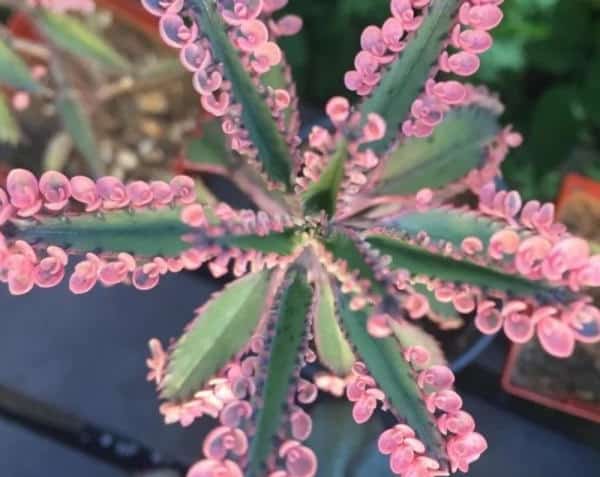
Kalanchoe ‘Pink Butterflies’ got its name from its young shoots, which resemble pretty pink flowers emerging from the edges of its leaves. Sadly, these beautiful young shoots have a short lifespan. Nevertheless, this succulent plant will add a touch of elegance to any space.
Kalanchoe pinnata
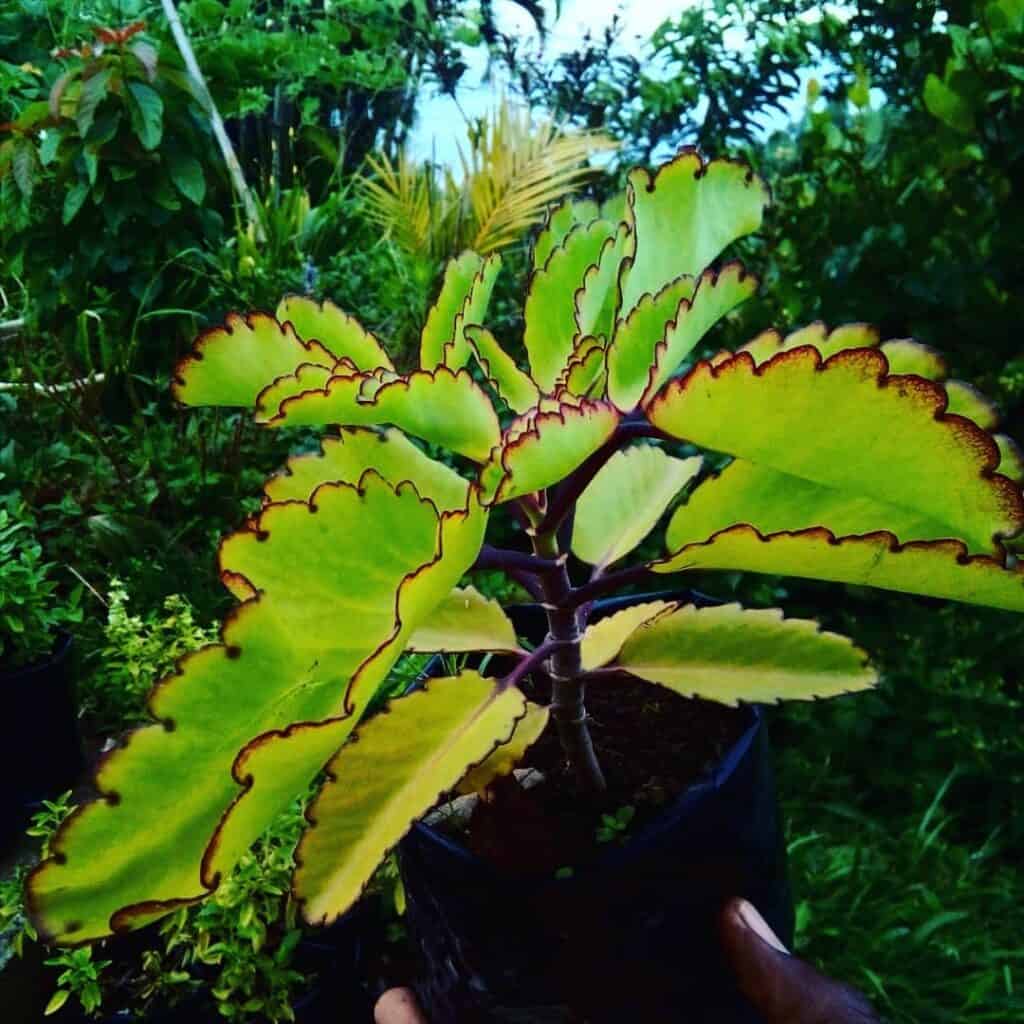
Kalanchoe pinnata is a succulent shrub that grows 0.3-2 meters tall, with little-branched, cylindrical stems. The leaves are arranged in opposite pairs, with upper leaves being 3- or 5-foliate and lower leaves simple. The leaf-blades are elliptic, 5-25 cm long, and 2-7 cm wide, with crenate edges. This plant produces young plants at the marginal notches of leaves, especially after detachment. Its flowers are pendulous, with a papery, inflated calyx and a yellowish-green corolla tinged with pink or reddish. The flowers appear in panicles, with slender pedicels.
Kalanchoe prolifera
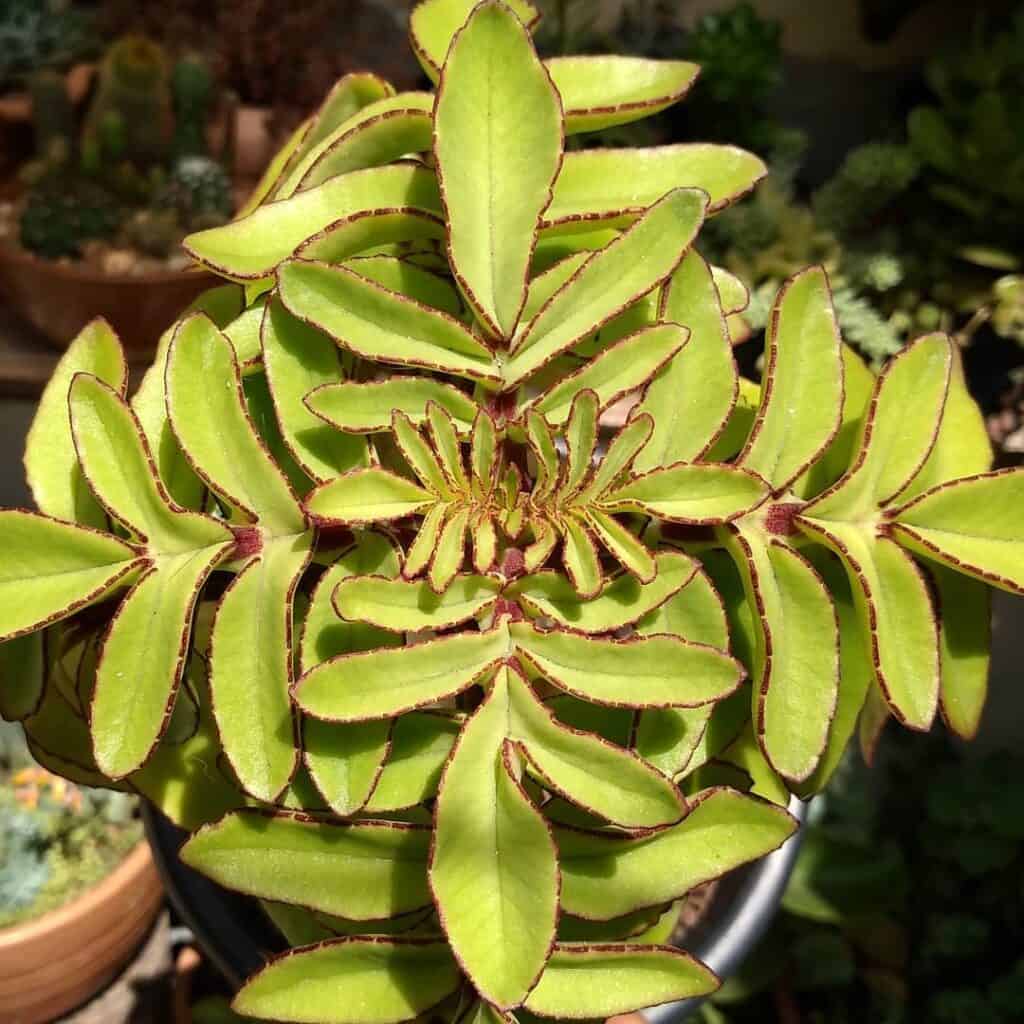
Kalanchoe prolifera, also known as Blooming Boxes, is a fast-growing succulent with a stout, unbranched stem and pinnately compound leaves. The stem is 4-angled with visible leaf scars and can grow up to 10 feet tall. The green leaves often have reddish-purple petioles and margins.
After several years, the plant produces a compound panicle of pendent flowers in late winter or early spring, reaching up to 32 inches in height and 16 inches in width. The tubular flowers, which can be red, green, or yellow, grow up to 1 inch long. The plant dies after blooming but often regrows from new stems, and many bulbils form in the inflorescence, making it easy to establish a colony.
Kalanchoe pubescens
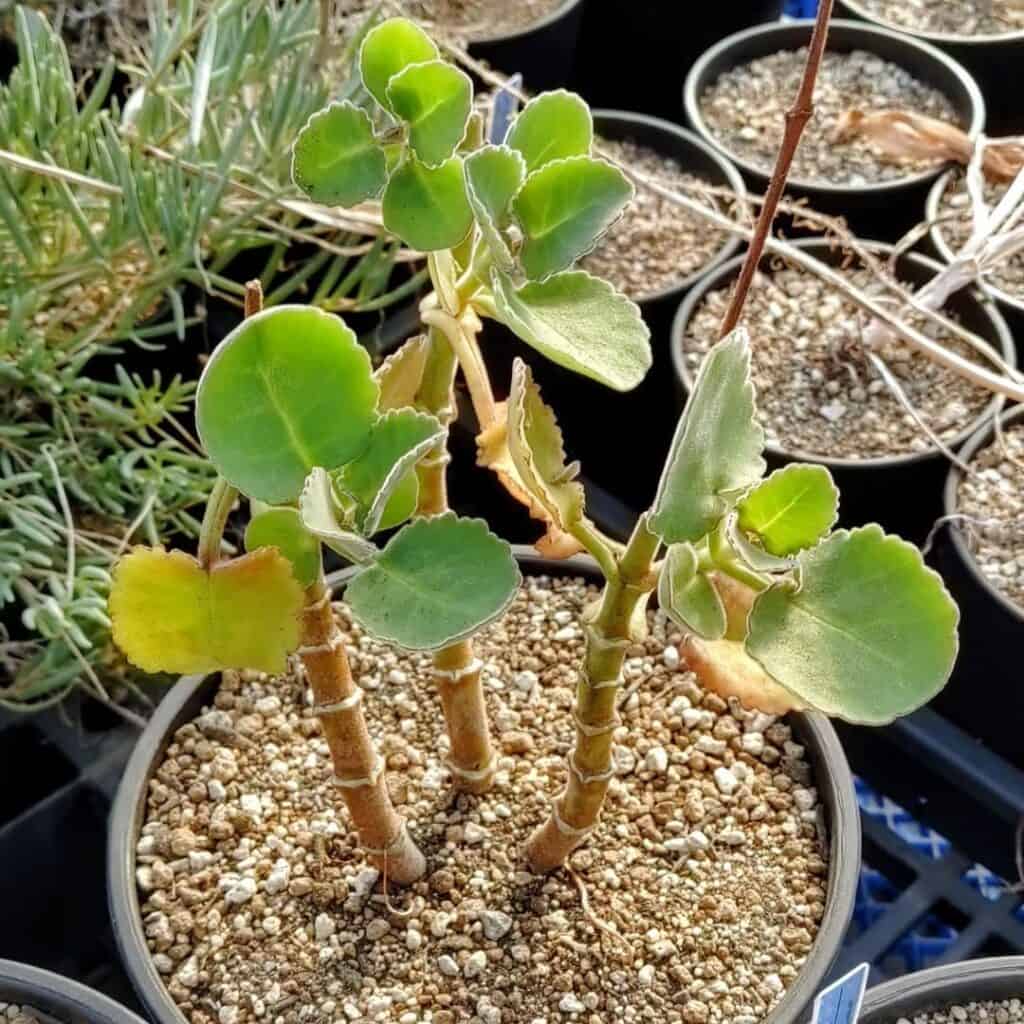
Kalanchoe pubescens, also known as Widow’s-thrill, is a succulent with large, soft, grey-green leaves covered in fine hairs. It produces clusters of apricot-red bell-shaped flowers with intricate veining. This plant typically reaches about 70–80 centimeters in height when flowering but can grow up to 1 meter by 1 meter.
Kalanchoe pumila
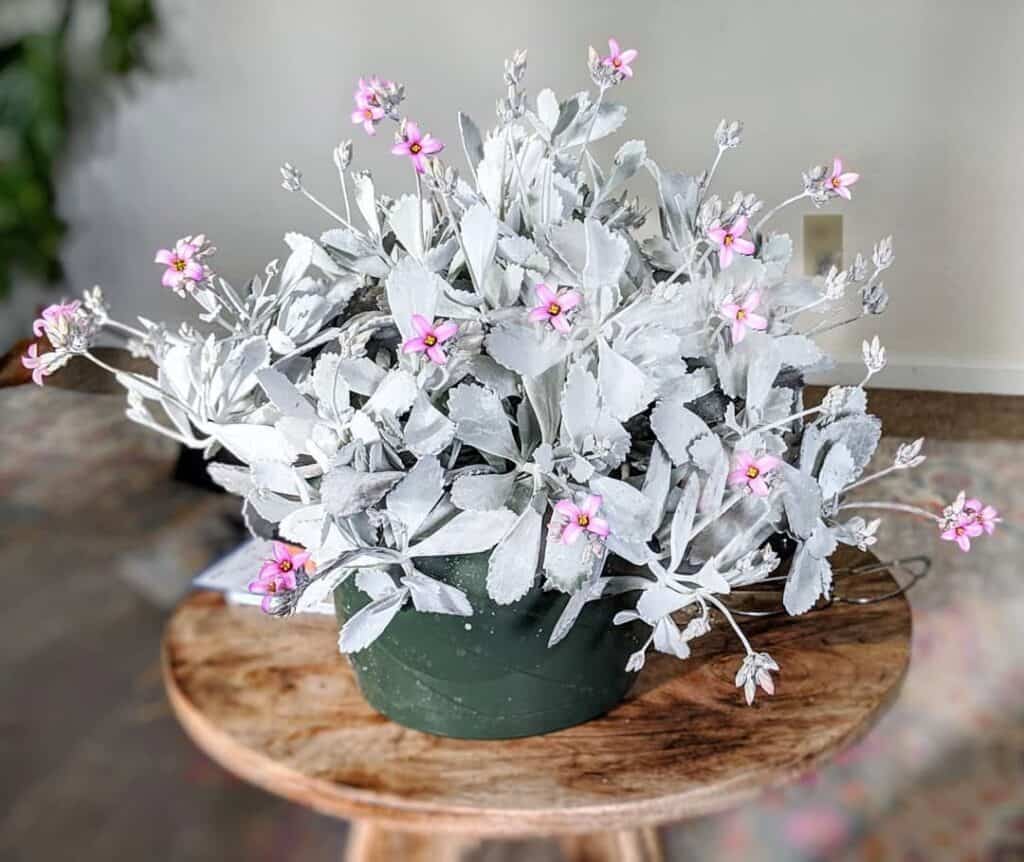
Kalanchoe pumila, also known as the Flower Dust Plant, is a shrubby succulent with arching stems and fleshy leaves covered in a white powdery layer. It can grow up to 12 inches tall. The obovate leaves have purple toothed margins and can reach up to 1.6 inches long and 0.8 inches wide. This white bloom on the leaves is easily removed. In late winter to early spring, it produces erect flowers that are red to purple or pink with noticeable yellow anthers, arranged in few-flowered clusters.
Kalanchoe rhombopilosa
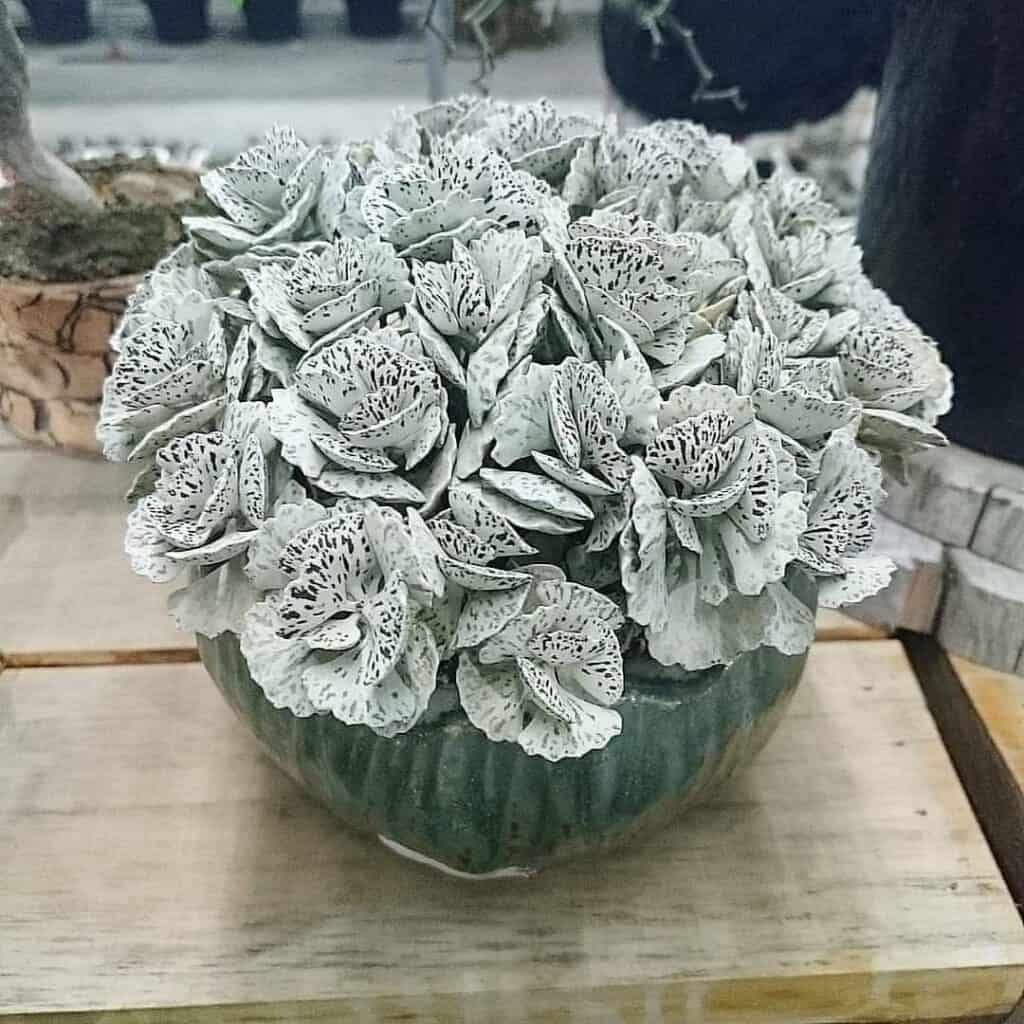
Kalanchoe rhombopilosa, also known as Pies from Heaven, is a beautiful succulent with woody stems that can be upright or sprawling. These stems have long, soft hairs and bear silvery-green, slightly woolly leaves with brown markings. The plant grows up to 12 inches tall, and its thick, fleshy leaves are very fragile, measuring up to 1.2 inches long. In spring, it produces small flowers that are greenish-yellow to pink with purple lines.
Kalanchoe rotundifolia
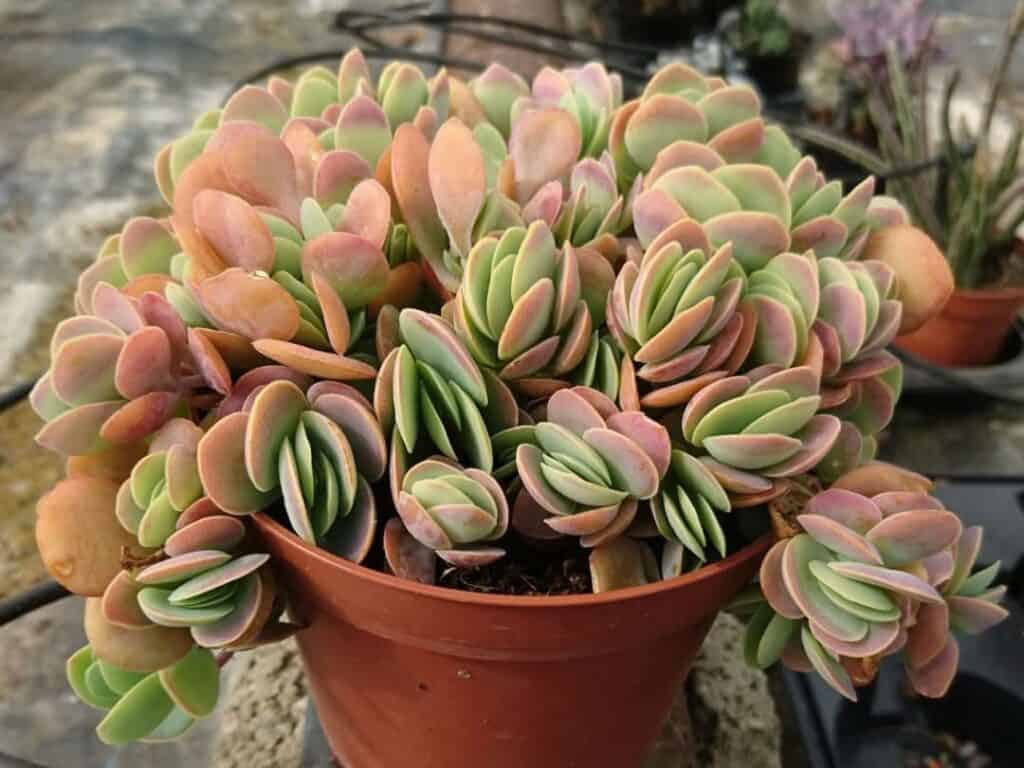
Kalanchoe scapigera
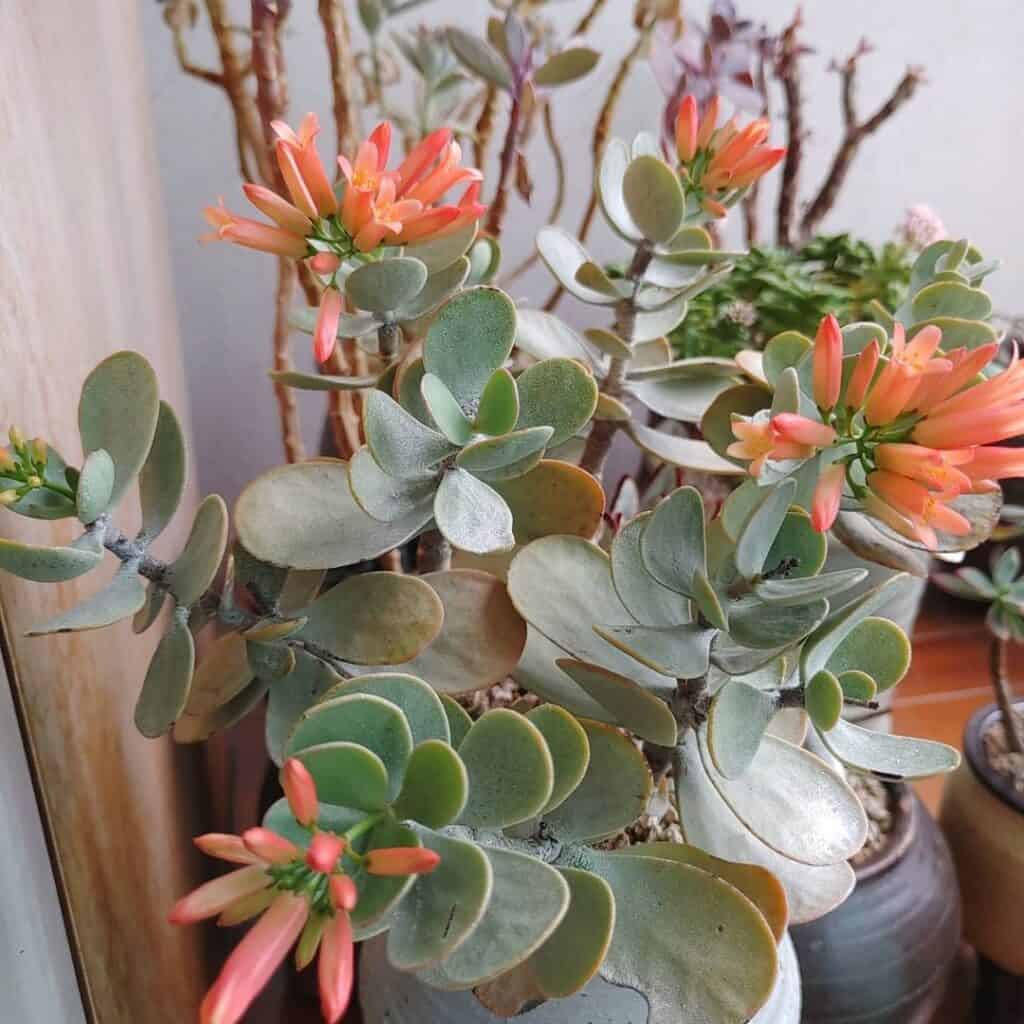
Kalanchoe scapigera, also known as Mealy Kalanchoe, is a small succulent with short woody stems and round reddish to yellow copper leaves at the tips. It grows up to 6 inches tall. The thick, fleshy leaves are almost disc-shaped, measuring up to 1.6 inches long and 0.8 inches wide. The cylindrical or slightly tapering stems are rugose and sparingly branched, growing up to 1.2 inches tall. The plant produces salmon-red tubular flowers on inflorescences, and the entire plant is covered with a white powdery coating.
Kalanchoe sexangularis
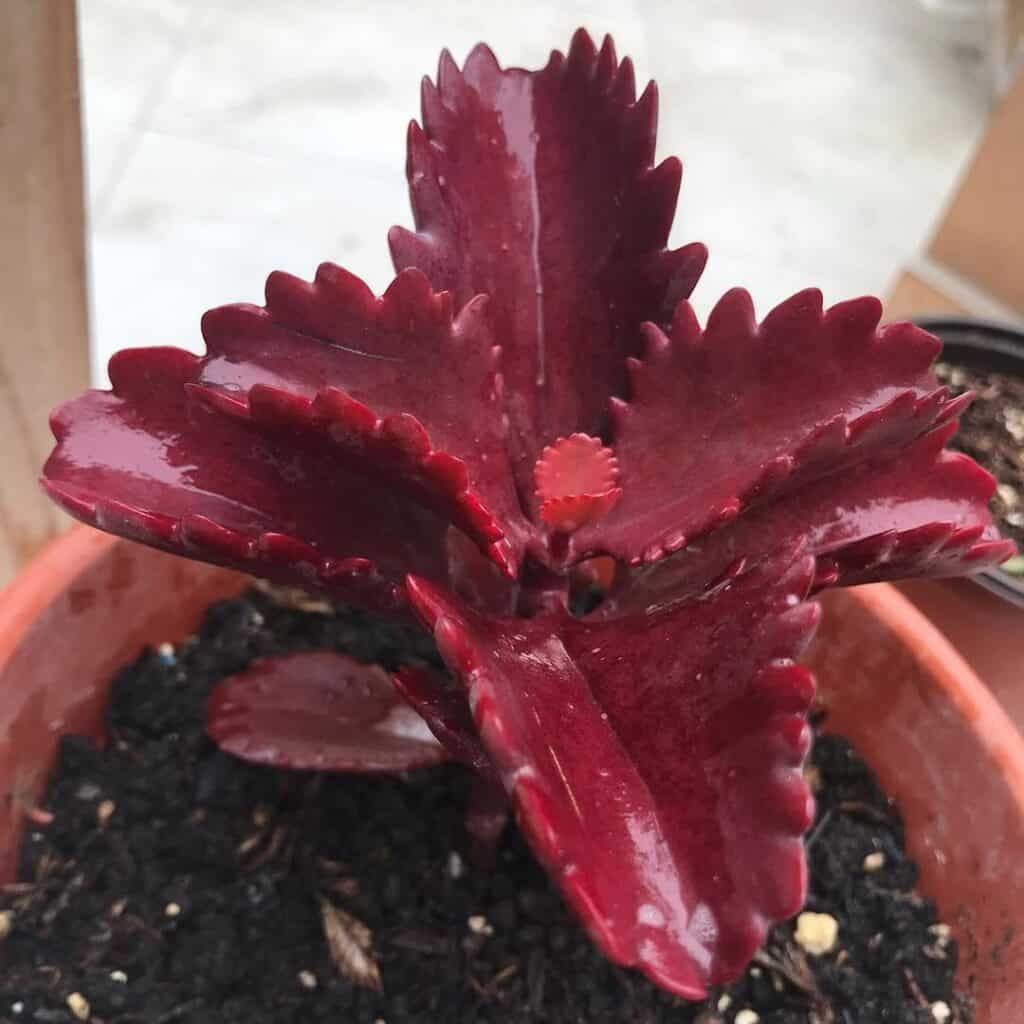
Kalanchoe sexangularis, known as Six-angled Kalanchoe, is a sparse succulent with few reddish, erect or decumbent branches. It has broadly elliptic to ovate green leaves that can turn deep ruby-red and have strongly scalloped edges. This plant grows up to 3.3 feet tall, with leaves up to 4.8 inches long and 3.2 inches wide, folded lengthwise and recurved. In winter and spring, it produces much-branched, flat-topped yellowish-green and yellow inflorescences up to 12 inches tall.
Kalanchoe synsepala
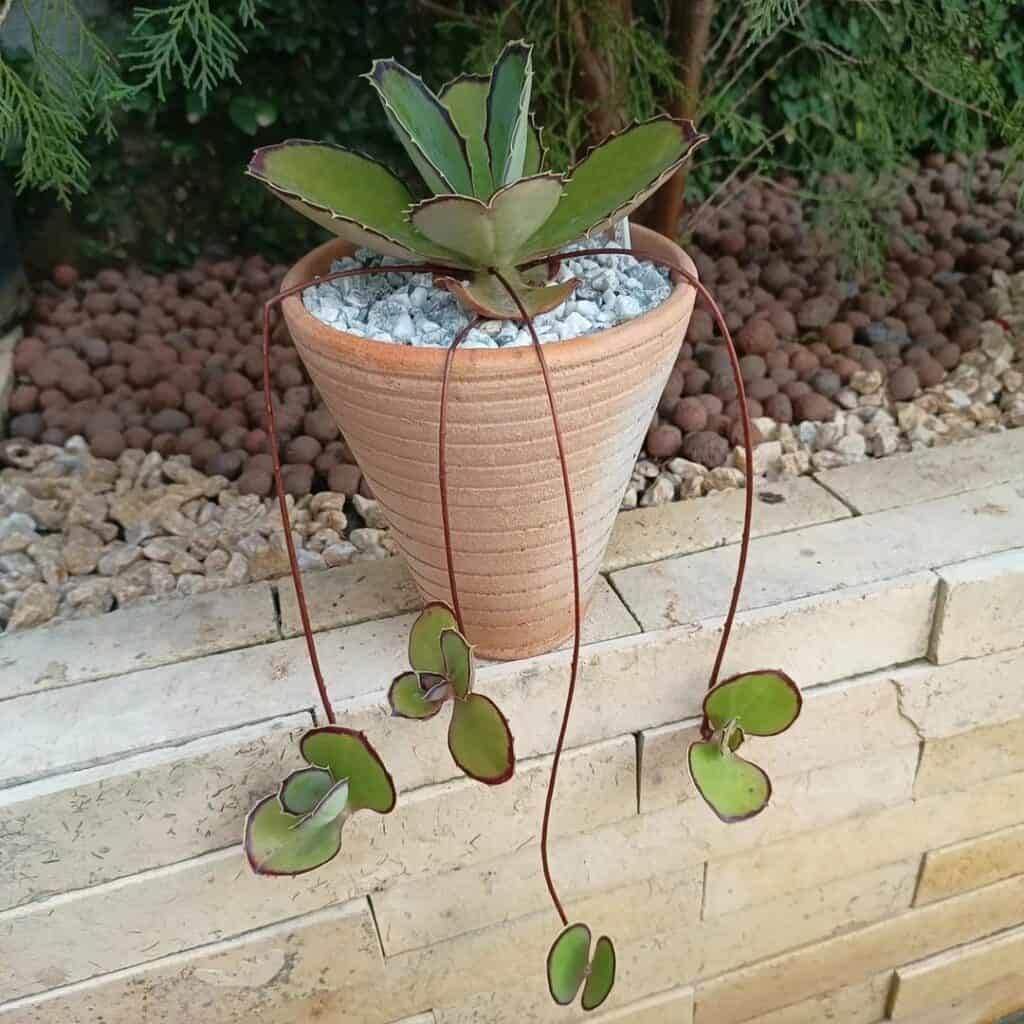
Kalanchoe synsepala, known as Walking Kalanchoe, is a succulent with thick, fleshy grey-green leaves that have pink-purple edges. It can vary in size and shape, growing up to 20 inches tall. The leaves are round, up to 6 inches long and 2.8 inches wide, with margins that can be smooth, toothed, or sometimes divided. The plant produces baby plants at the ends of long stems that bend to the ground and root, giving it its common name. In mid-fall, it blooms with small, pale pink to reddish tubular flowers in dense clusters.
Kalanchoe ‘Tessa’
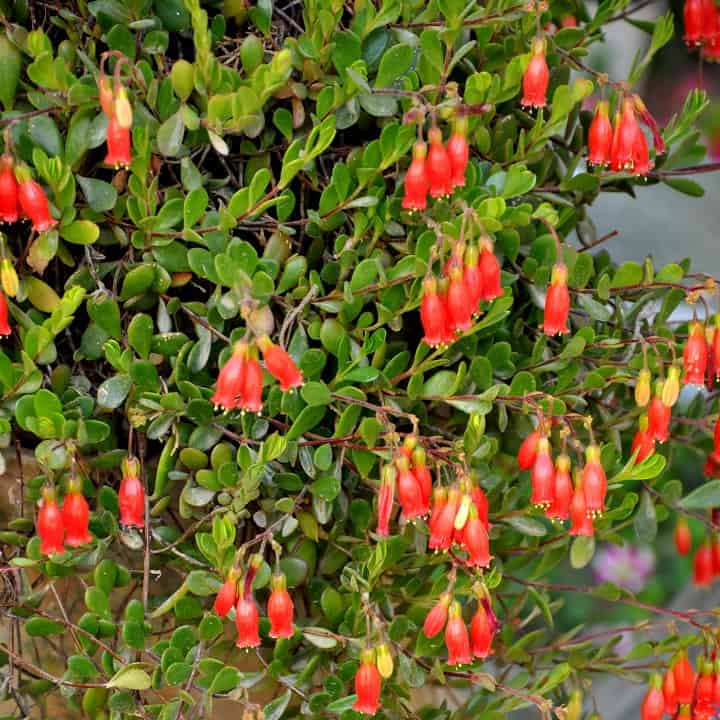
Kalanchoe ‘Tessa’ is a special hanging kalanchoe that received the prestigious Royal Horticultural Society’s Award of Garden Merit. With its maximum height of 30 centimeters, this stunning plant features slightly serrated and fleshy leaves. Its eye-catching pink to red flowers, which are tubular or bell-shaped, bloom from delicate stems. The best part? You can grow this beautiful kalanchoe both indoors and outdoors.
Kalanchoe tetraphylla
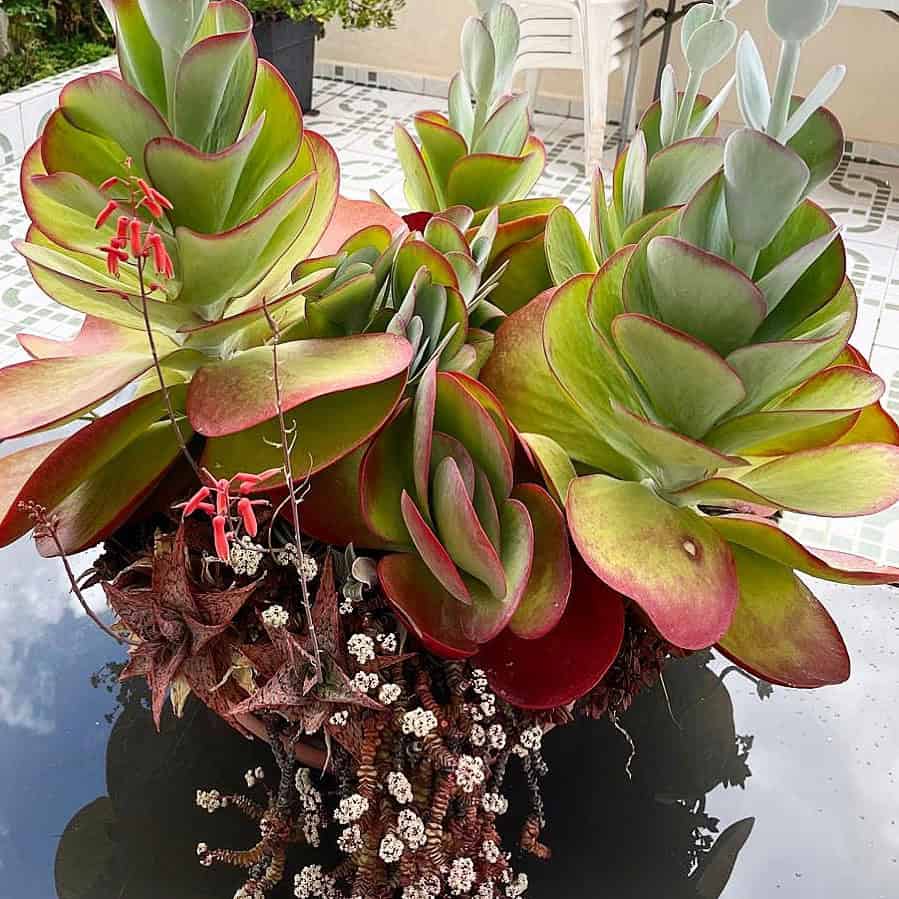
Kalanchoe tetraphylla is a succulent with an upright, woody stem and a terminal rosette of broad reddish or green leaves with serrated edges. The stem usually stays short but can grow up to 5 feet tall. The leaves, up to 6 inches long and wide, are densely hairy when young but become smooth with age. In fall, it produces dense clusters of bell-shaped flowers with green to reddish sepals and white-yellow to yellow-green petals streaked with purple, all covered in white hairs. Unlike most Kalanchoe species, its flowers grow from the leaf axils, not the stem tips.
Kalanchoe thyrsiflora
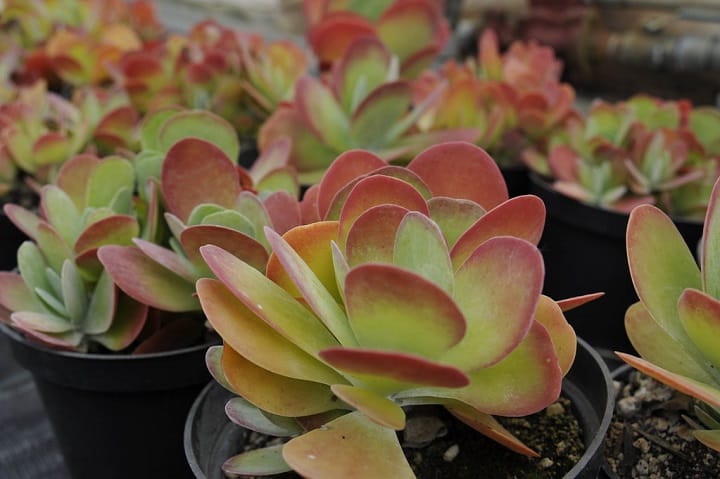
Kalanchoe thyrsiflora is a versatile plant that can be grown both in soil and in pots. To flourish, it needs plenty of natural light. Its large, rounded leaves are light green in the center and pink at the tips, which adds a captivating touch to its overall beauty.
Kalanchoe tomentosa
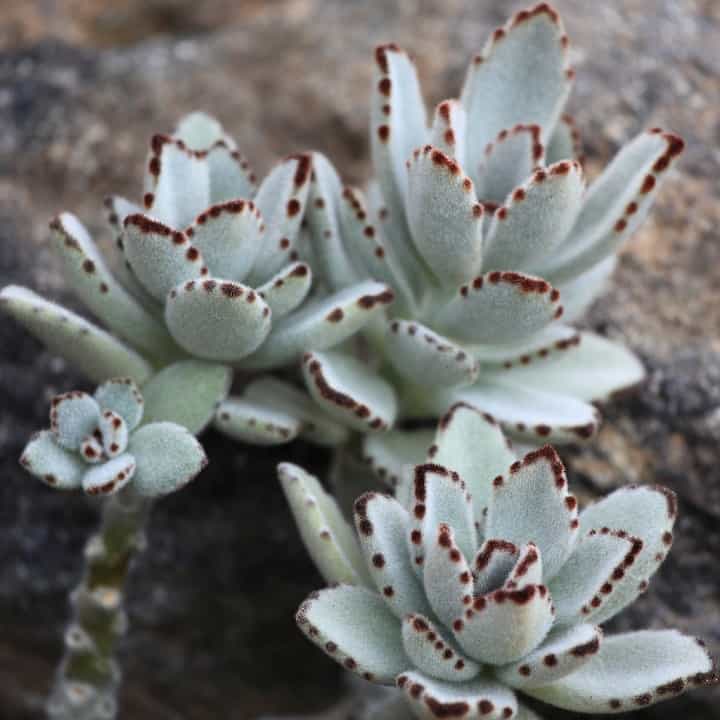
Prepare to be amazed by Kalanchoe tomentosa! This unique plant has leaves that form a star shape and grows at a slow pace, reaching heights of up to one meter. Its leaves are covered in tiny whitish hairs, giving it a soft and velvety feel. You’ll also notice brown spots on the tips of its serrated leaves. There are several varieties of Kalanchoe tomentosa, including the classic one, Chocolate Soldier, and Variegata.
Kalanchoe tomentosa ‘Chocolate Soldier’
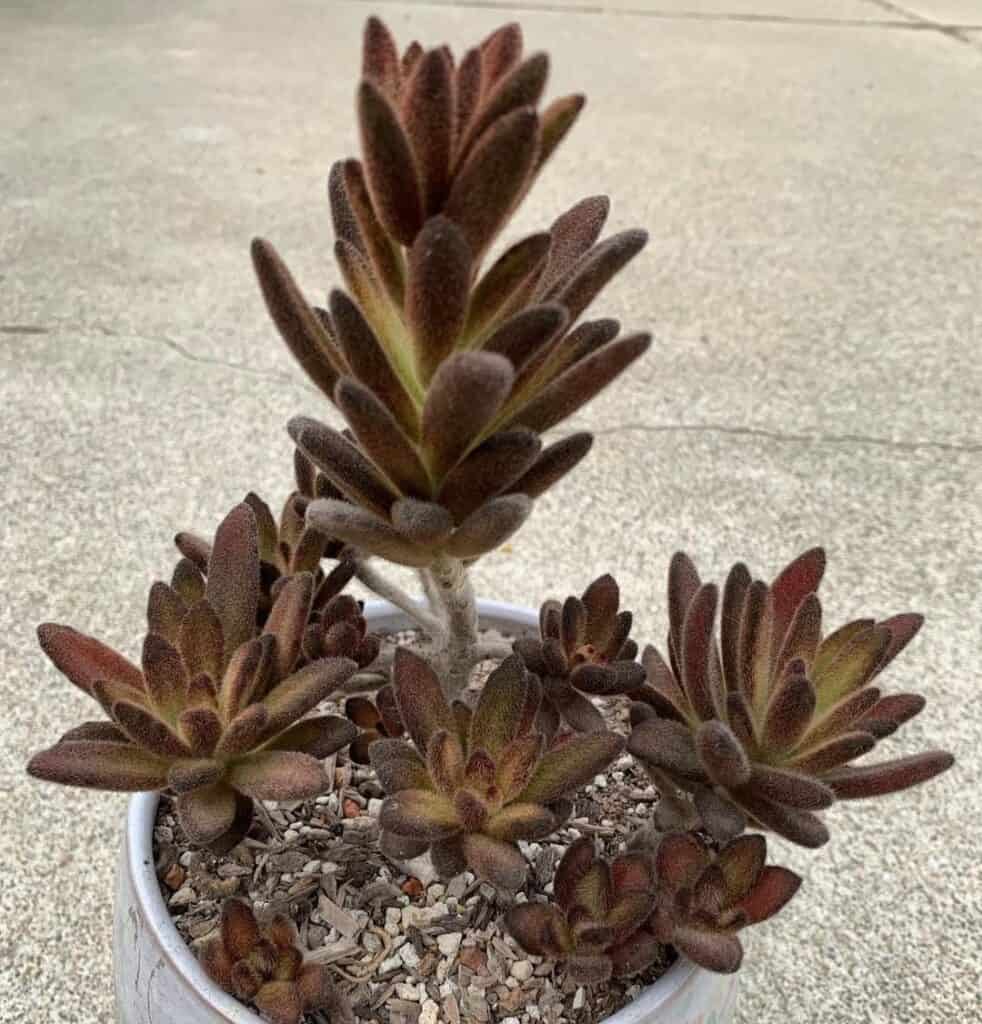
Kalanchoe tomentosa f. variegata
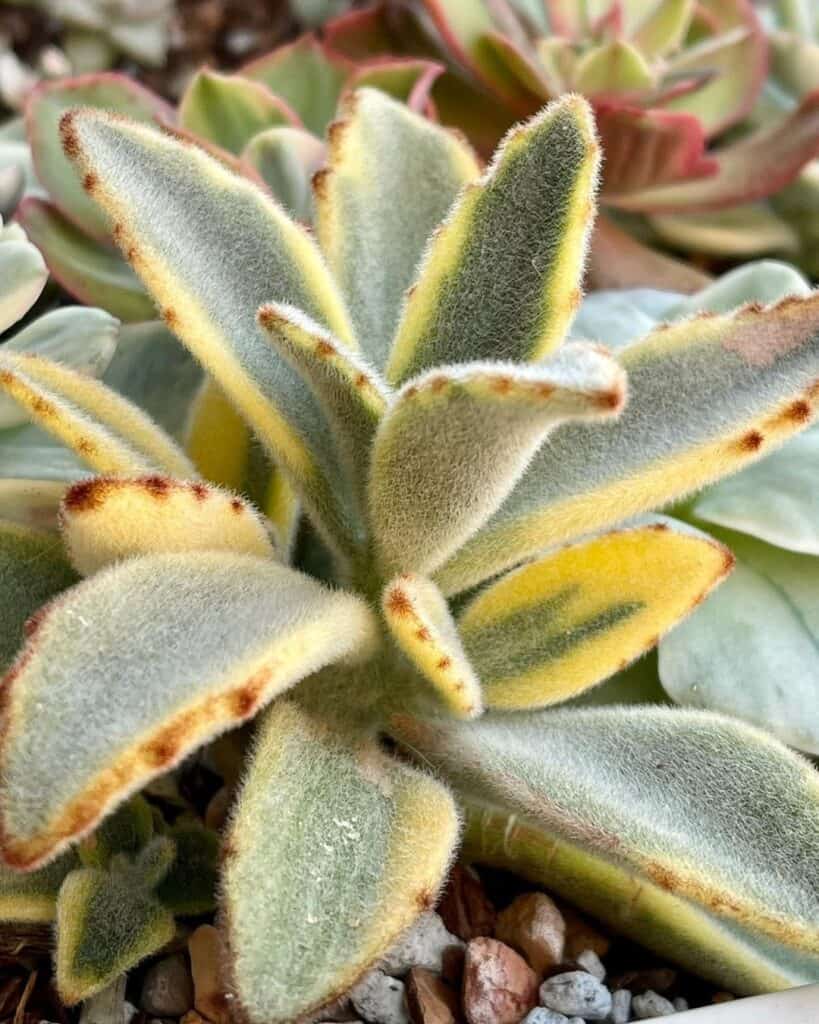
Kalanchoe tubiflora
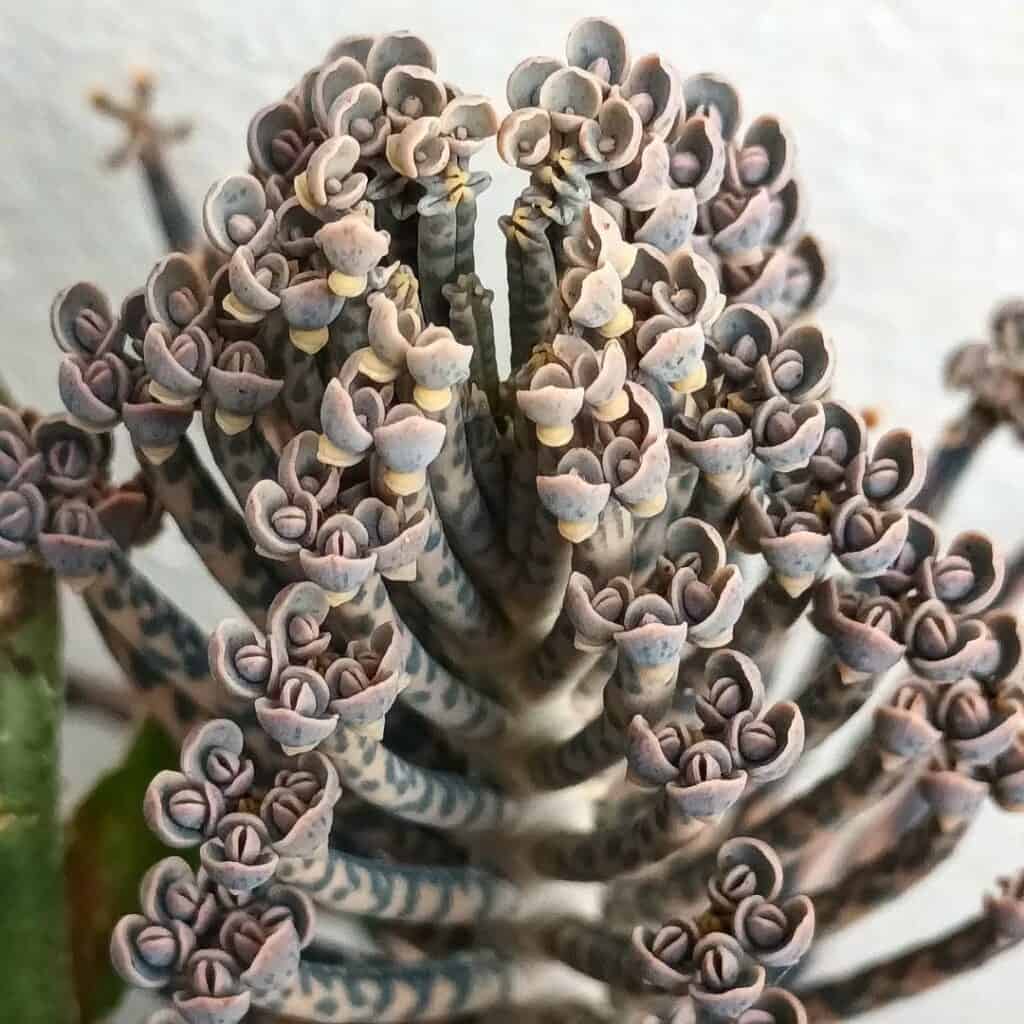
Kalanchoe uniflora
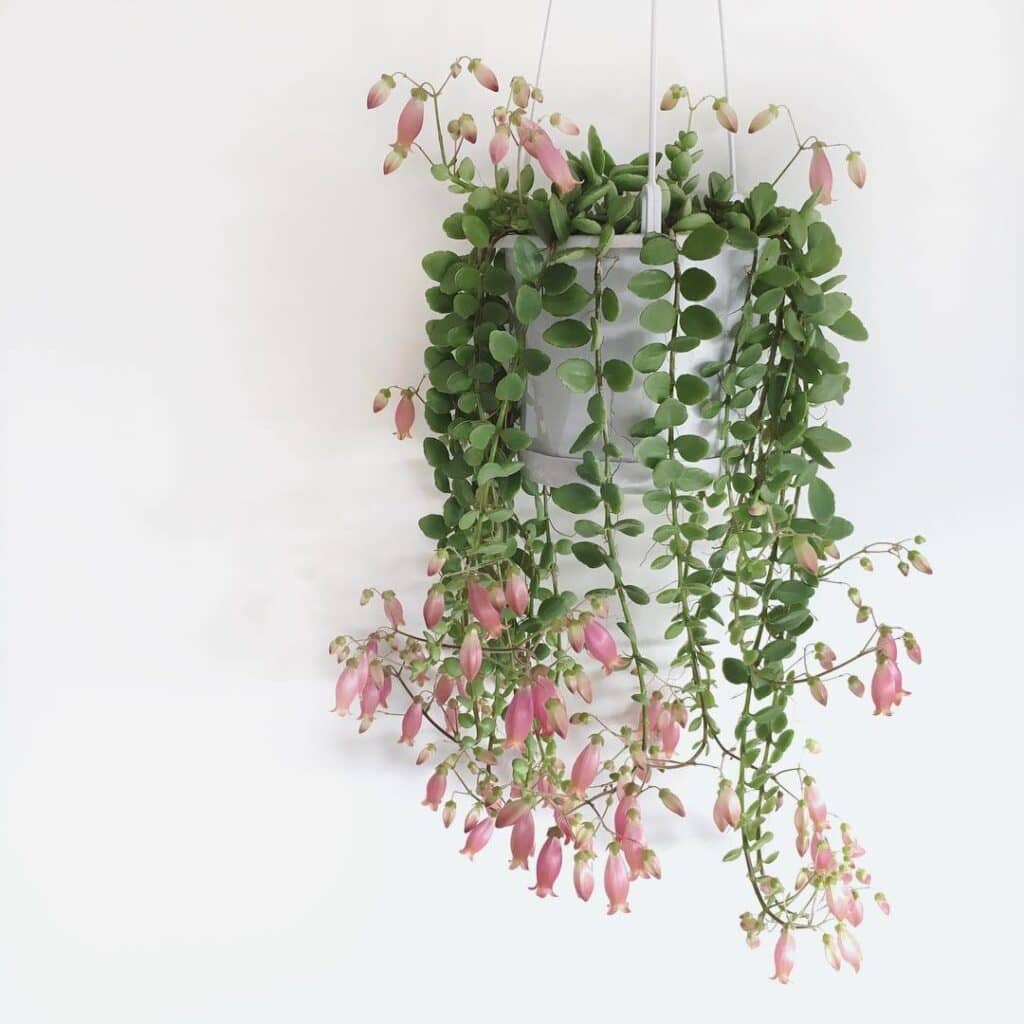
Kalanchoe uniflora, also known as Coral Bells, is an eye-catching epiphytic succulent with slender, prostrate or climbing stems that can reach up to 3.3 feet long. These stems root at the nodes. Its fleshy, bright green leaves can grow up to 1.4 inches long and 0.6 inches wide. The plant produces bright red to red-violet, bell-shaped flowers up to 0.8 inches long. Contrary to its name, it rarely has just one flower.
Kalanchoe Care Guide
While they’re relatively low-maintenance compared to many houseplants, there are several key factors you’ll need to understand to keep your Kalanchoe thriving and flowering year after year. Let’s explore the essential care requirements that will help you transform your Kalanchoe from surviving to flourishing.
Light and Temperature Requirements
When it comes to light exposure, Kalanchoe succulents thrive in bright, indirect sunlight for 4-6 hours daily. While they can tolerate some direct morning sun, protect them from harsh afternoon rays to prevent leaf burn.
Keep your Kalanchoe at temperatures between 60-85°F (15-29°C). Don’t let them stay in temperatures below 50°F (10°C), as cold damage can occur.
Water and Soil Tips
Your Kalanchoe needs well-draining soil and careful watering to prevent root rot. Mix cactus soil with perlite or coarse sand in a 2:1 ratio for ideal drainage. Water thoroughly only when the top 2 inches of soil feel dry, and let excess water drain completely.
During winter, reduce watering by half. Always empty the saucer beneath the pot to avoid standing water.
Pruning and Maintenance
Regular pruning keeps Kalanchoe succulents compact and encourages better blooming. You’ll need clean, sharp scissors to remove dead flowers, yellowing leaves, and overgrown stems.
- Cut spent blooms at the base of their stems to promote new flower development
- Remove any damaged or discolored leaves as soon as you spot them
- Trim leggy growth back to the main stem during spring
Blooming and Propagation Methods
Proper maintenance sets the stage for Kalanchoe’s stunning blooming cycles. You’ll see flowers bloom for several weeks during fall and winter.
To propagate, take 4-inch stem cuttings, remove lower leaves, and let them dry for two days. Plant the cuttings in well-draining soil and water lightly. You can also propagate using healthy leaves placed on top of soil.
Common Pests and Problems
Despite their hardy nature, Kalanchoe succulents can fall victim to several common pests and diseases. Your plant may encounter issues that need prompt attention to maintain its health and vigor.
- Mealybugs leave white, cotton-like deposits on leaves and stems – treat with rubbing alcohol
- Root rot develops from overwatering – reduce watering and improve drainage
- Spider mites cause yellow spots – spray leaves with neem oil solution
Frequently Asked Questions (FAQs)
Is Kalanchoe poisonous to humans?
The most commonly grown indoor variety of Kalanchoe is the Flaming Katy (Kalanchoe blossfeldiana). It’s a beautiful plant with colorful flowers and attractive leaves that make it a popular choice for room decoration and terrace gardens.
While the Flaming Katy is generally considered non-toxic, it’s important to note that the plant’s constituents haven’t been extensively studied. There have been rare cases of babies experiencing vomiting and abdominal pain after consuming parts of the plant.
On the other hand, other Kalanchoe species like Kalanchoe Beharensis are considered poisonous due to the presence of cardiac glycosides, which can cause symptoms such as vomiting, diarrhea, and cardiovascular problems. It is crucial to keep these plants out of the reach of children.
Pro Tip:
Remember, even if a plant is classified as non-toxic, it’s best to position it out of reach of babies and toddlers. What might be harmless for adults can have much stronger effects on children.
Is Kalanchoe toxic to cats?
While many Kalanchoe species are non-toxic to humans, unfortunately, this does not apply to our furry friends. Cats are highly sensitive to the acids present in Kalanchoe leaves. If a cat ingests the plant, it can experience difficulty breathing, seizures, and paralysis. It is advisable to avoid having Kalanchoe plants in households with cats, or at the very least, ensure they are placed in areas where cats cannot access them for nibbling.
Is Kalanchoe poisonous to dogs?
Dogs are known to be particularly sensitive to the cardiotoxic effects of Kalanchoe plants. According to reports from the ASPCA Animal Poison Control Center, common signs of Kalanchoe ingestion in dogs include vomiting, depression, lethargy, and diarrhea. Other symptoms may include weakness, difficulty breathing, loss of appetite, rapid heartbeat, and vocalization. While no deaths have been reported in dogs due to Kalanchoe ingestion, it’s crucial to keep these plants away from your canine companions.
Do Kalanchoe plants rebloom?
With proper care, Kalanchoe plants can bloom repeatedly, adding a burst of color to your windowsill when many other houseplants may not be flowering. Kalanchoe plants typically bloom when they receive less than nine hours of light per day. In our region, this period usually occurs during the winter months when the days are shorter. To learn more about how to make Kalanchoe plants rebloom, check out our dedicated article on the topic.
